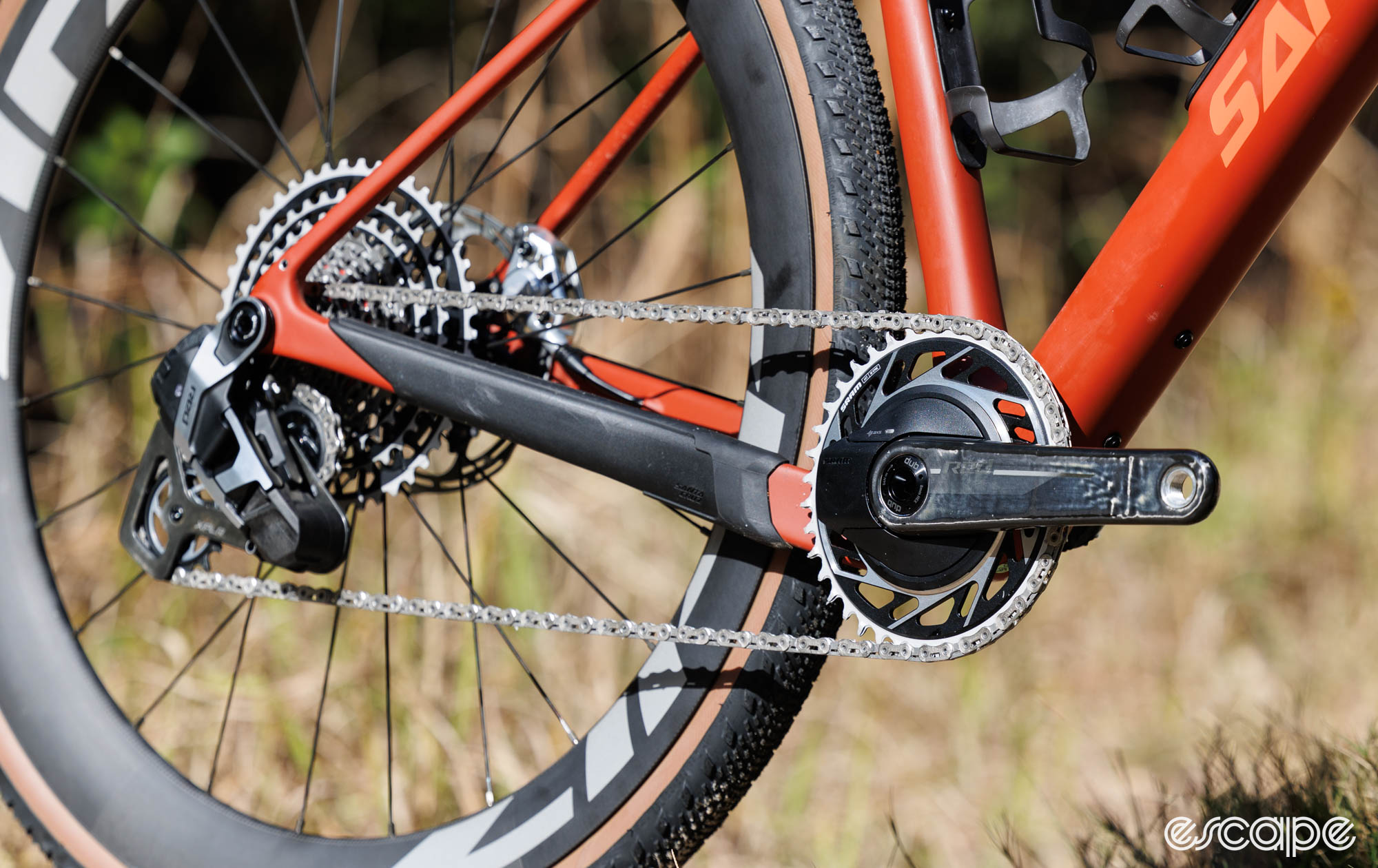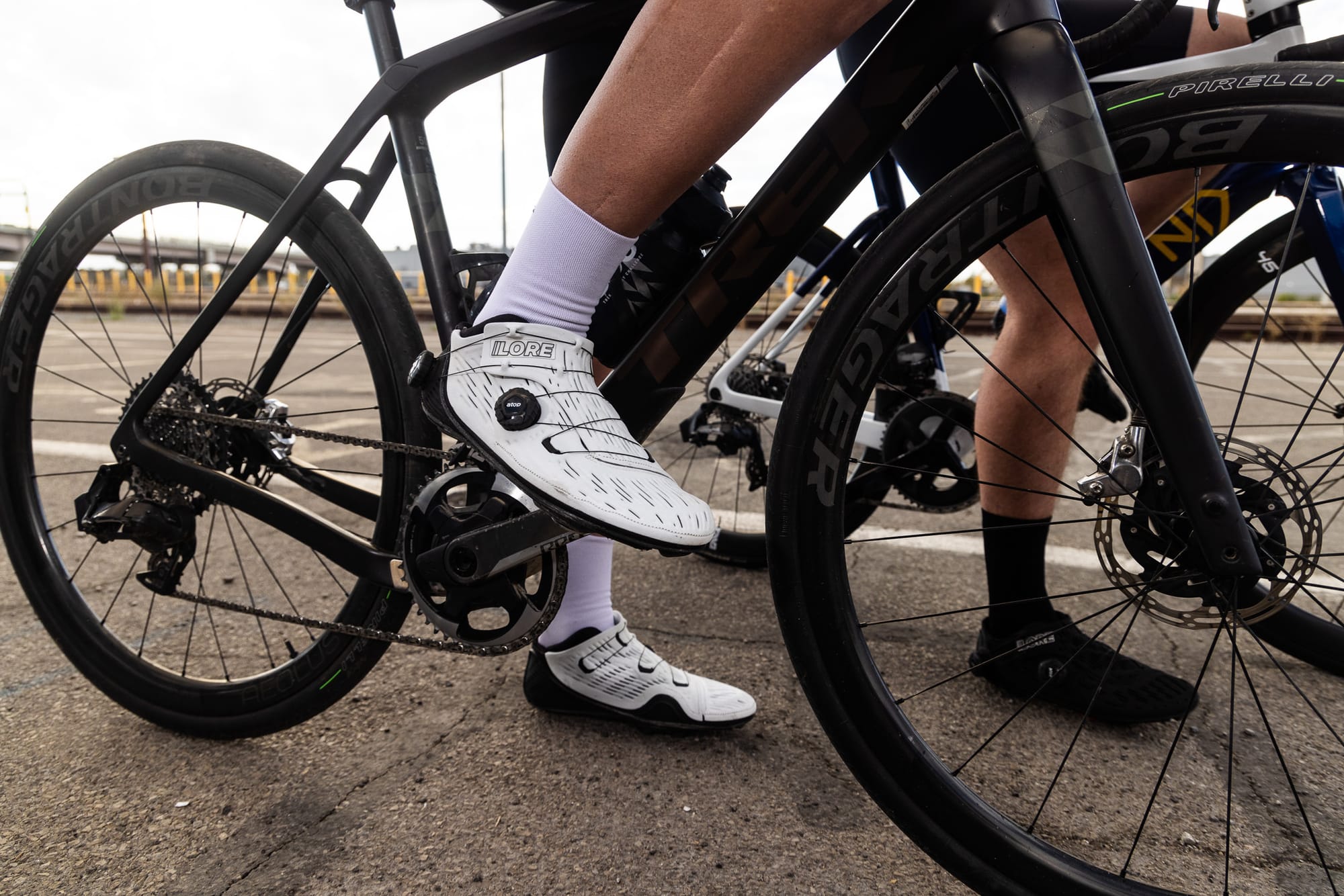It feels like the chrome has barely set on the new SRAM Red AXS E1 road groupset yet here we are with a review of another top-tier dropbar groupset from the American company. This time, it’s the much-anticipated Red XPLR AXS E1 1x group for all-road and gravel pursuits, and there’s a whole lot to talk about here.
SRAM has merged bits and pieces of its road and mountain bike tech to create a groupset that brings a number of new concepts to the dropbar world. The "too long; didn’t read" version is that the new Red XPLR groupset eliminates the traditional derailleur hanger by using the Full Mount interface of SRAM’s mountain bike Transmission systems. It uses the new and greatly improved braking of the new Red AXS levers. It’s 1x-specific and introduces a 13-speed cassette with a 10-46T range that aims to better match the tighter gear gaps afforded by 2x systems. A replaceable 1x chainring solves a complaint present in the Red road power meter. There’s still a surprising amount of backward compatibility and interchangeability in the wireless system. And it all works impressively well.
Obviously, Red XPLR AXS is priced sky high, but I’m willing to bet 100 quality 5 mm hex keys that the technology and concepts released here will quickly trickle down to more attainable price points. Or to not let a bad pun go to waste, SRAM will be transmissioning in this direction. This stuff is going to look quite normal in a few years.
This article is an in-depth explainer and review. Before we dig into the details, it’s worth noting that this new flagship gravel groupset release coincides with Zipp’s new line of extremely wide gravel race wheels. There’s also a new matching handlebar. See our coverage of the new Zipp XPLR line for details and ride thoughts.
Bad stuff: Still not wide enough range for all forms of gravel, derailleur is forever locked into the 10-46T size cassette, brakes have a lot of freestroke with lever reach brought in, new derailleur won’t fit a lot of gravel bikes in use, US$600 cassette, DUB cranks get real tight to remove.
Note: The new SRAM Red XPLR AXS has the same name as the groupset it supersedes. To help differentiate the generations, SRAM uses an alphabetical coding system. The previous Red AXS generation is known as “D1,” while this latest stuff is coded as “E1.”
From the road side of things
The new Red XPLR AXS group has some brand-new and unique components to it, but in many ways, they’re parts and concepts we’ve seen (and covered) before.
Despite being at a SRAM road product launch just a few months ago, SRAM did a good job of keeping the media in the dark about this XPLR release. Still, in reviewing the new Red AXS road group, it was clear that the new shifters and brakes also offered significant advantages for gravel riders.
As previously covered, the biggest and best update in SRAM’s recent Red AXS road groupset release was the overhauled shifters and brakes – pieces that are now shared with the new Red XPLR. To quickly recap, the company wholly revamped the external shape and internal structure in order to move the brake master cylinder piston from an inefficient vertical position to one that runs horizontally through the lever body and works much like a mountain bike brake.
Along with some revisions in the shiny new brake caliper, the new brake is said to require just 1/5th of the effort when braking from the hoods, and 1/3rd of the effort when in the drops. The difference in lever effort is truly night and day, plus the general lever feel and power are now more consistent (linear), too.
These levers also got an ergonomic overhaul with more length for the palm (beware the 5 mm increase in hood reach), more lever angle to suit modern dropbar shapes, and simpler lever-reach adjustment. SRAM also added customisable bonus buttons for your thumbs to activate on the inner side and near to the top of the hood – out of the box they’re set up as an additional shift button, but you can change them to control cycling computers or an AXS dropper post.
The new hoods/brakes stick with DOT-5.1 brake fluid, use the same brake pad shape as before, are still powered by a CR2032 battery, and remain backward compatible with all SRAM AXS wireless derailleurs, including previous road, XPLR, and mountain bike models. I encourage you to read my recent review of the Red AXS 2x road groupset if you wish to know more about these.


The lightened disc brake rotors and carbon crank arms (but not crankset) are now also shared between Red AXS (road) and Red XPLR AXS (gravel). Those crank arms drop approximately 30 grams from the previous version, while introducing an increased range of lengths covering 160, 165, 167.5, 170, 172.5, and 175 mm.
Where the Red XPLR AXS crankset does differ is in using SRAM’s ‘Wide’ (now called XPLR) axle width, which the industry is increasingly adopting to afford more tyre clearance on gravel bikes (Shimano has done similar with its GRX). This increased width moves the chainline out from 45 mm (SRAM road) to 47.5 mm. Meanwhile, the Q-factor grows from 145 mm in the road crank to 150 mm for this XPLR version. There are no changes to the DUB bottom brackets.
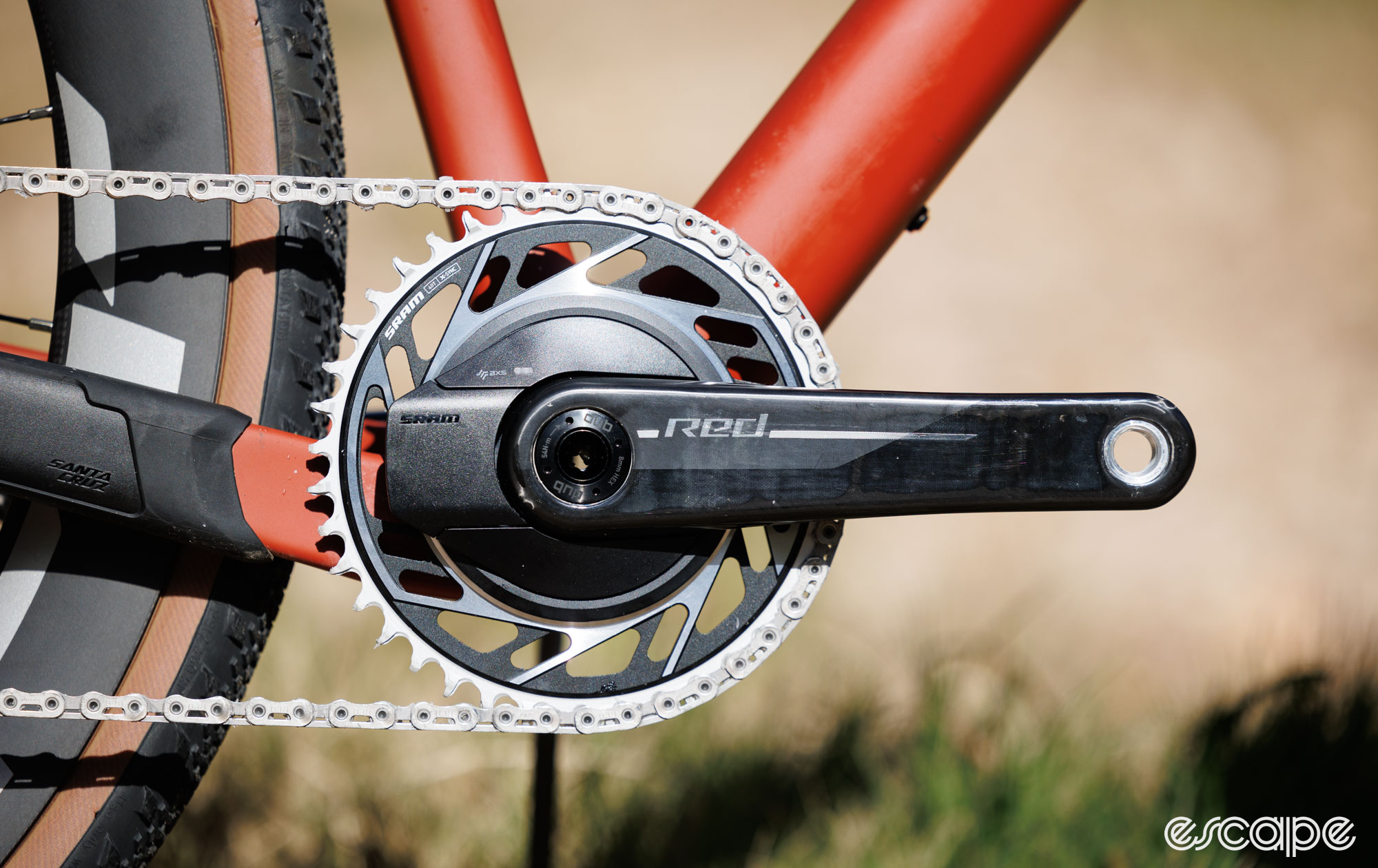
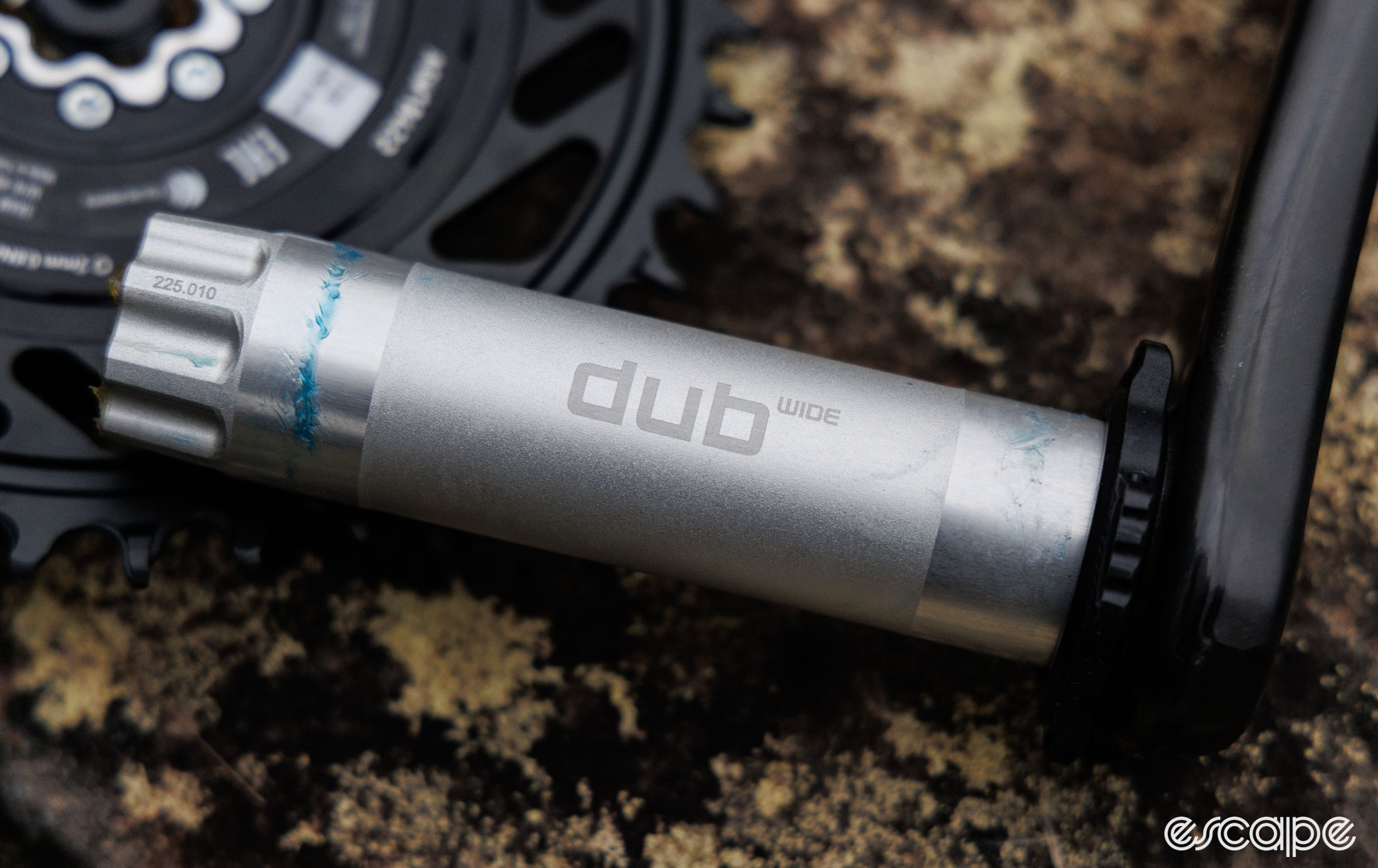
Despite Red XPLR going 13-speed, it uses the identical 12-speed Flat Top chain to Red AXS. Now at 126 links, this chain features the newly lightened design already seen, and SRAM is updating the packaging of the chain to show its 12- and 13-speed compatiblity. SRAM claim you must use the road version of the chain, but there’s seemingly little stopping you from using a SRAM T-type Transmission mountain bike chain in a pinch.
How did SRAM manage to keep the chain dimensionally the same while adding another cog? That is made possible by the new Full Mount rear derailleur …
From the mountain bike side of things
In early 2023, SRAM had one of its most significant releases with the introduction of its Eagle Transmission systems. Transmission introduced a bunch of new tech, but none more notable than the Full Mount system that sees the derailleur sandwich the open frame dropout in place of a Universal Derailleur Hanger (UDH). To rewind further, SRAM had spent the prior few years encouraging mountain bike brands to adopt its UDH standard, claiming one derailleur hanger to rule them all is better for consumers (it is), but really they were laying the path for a new shifting system.
That Full Mount derailleur design brought along a few benefits. Firstly, there is no longer a derailleur hanger to bend or break in the event of a crash, dropped bike, or angry baggage handler. In the event the derailleur does get hit, it’s designed to pivot backward or shift inward, while the derailleur itself is incredibly robust, can take an actual kicking, and is largely repairable. That Full Mount then makes for a stiffer interface to handle heavy shifting loads. And with the position of the derailleur and cassette locked in by design, the setup is easier than ever and requires only simple tools.
Over the past couple of years, we’ve seen a number of gravel, all-road, and even pure road bikes begin to adopt the UDH standard. We’ve seen this trick play out before, so it was only a matter of time before we saw the Full-Mount derailleur arrive in the dropbar world. Indeed, that’s exactly what the new Red XPLR AXS does.
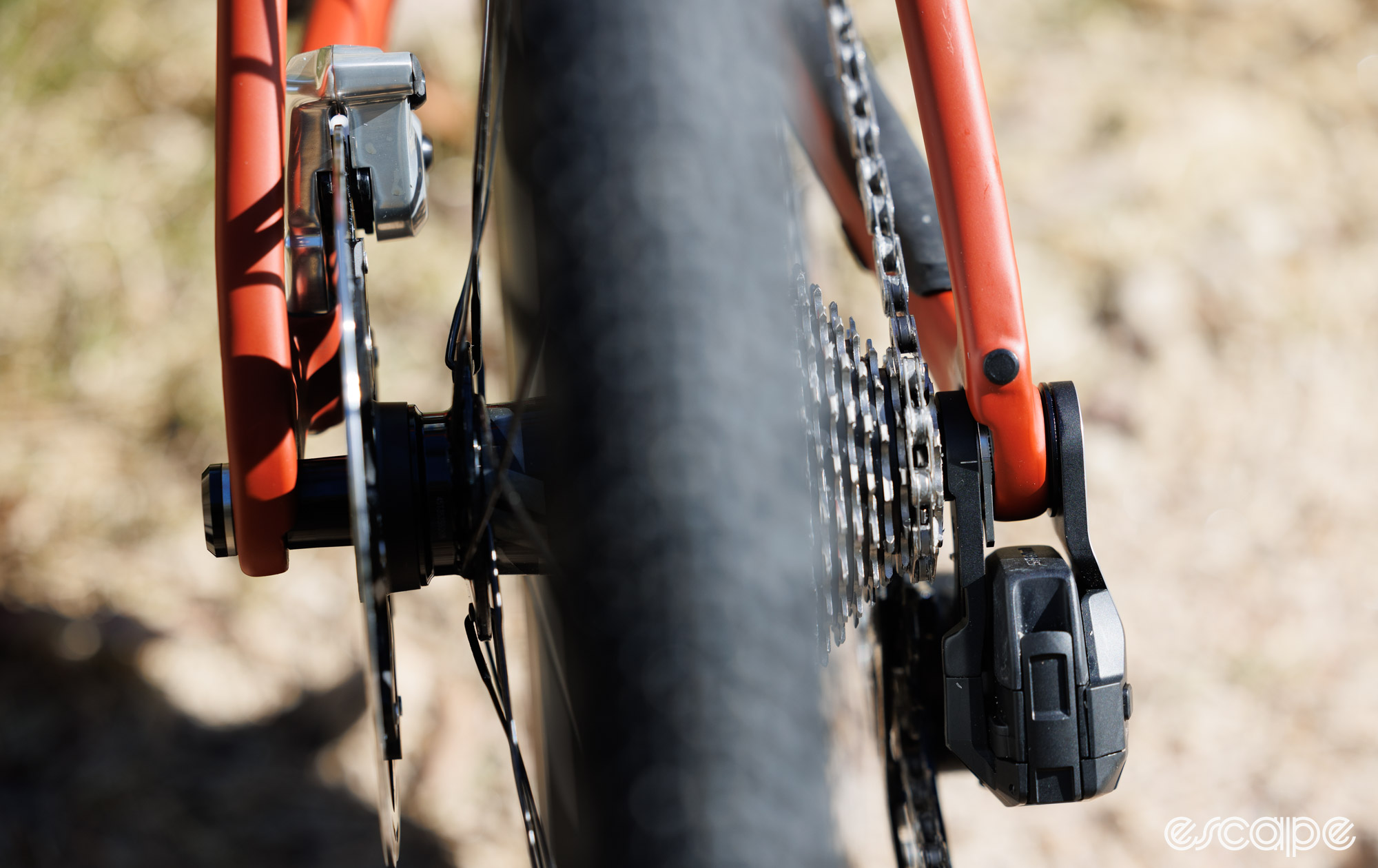
In order to run the new Red XPLR groupset you must have a frame with a UDH – a requirement that rules out compatibility with a huge number of bikes out in the wild. SRAM then requires gravel frames to have a minimum chainstay length of 415 mm, and that the chainline is 47.5 mm (provided by SRAM’s XPLR/Wide cranks). Alternatively, the system can also be equipped to road and all-road bikes with 405-415 mm chainstay lengths if accompanied by SRAM’s Aero road 1x crank (45 mm chainline).
The mountain bike Eagle Transmission derailleur is specifically matched to the 12-speed 10-52T cassette and a single chainring up front. Meanwhile, the new Red XPLR derailleur is also locked into a specific size of cassette and for use with only a single chainring up front, however, it takes things to 13-speed and tightens the range to 10-46T.
You can use the mountain bike Transmission derailleur and cassette on a UDH-equipped gravel bike, however, it doesn’t go the other way around. The new Red XPLR Full Mount derailleur is a dedicated gravel and related dropbar product, based on a 142 mm axle width, that narrower chainline, and not designed with mountain bike rear suspension in mind.
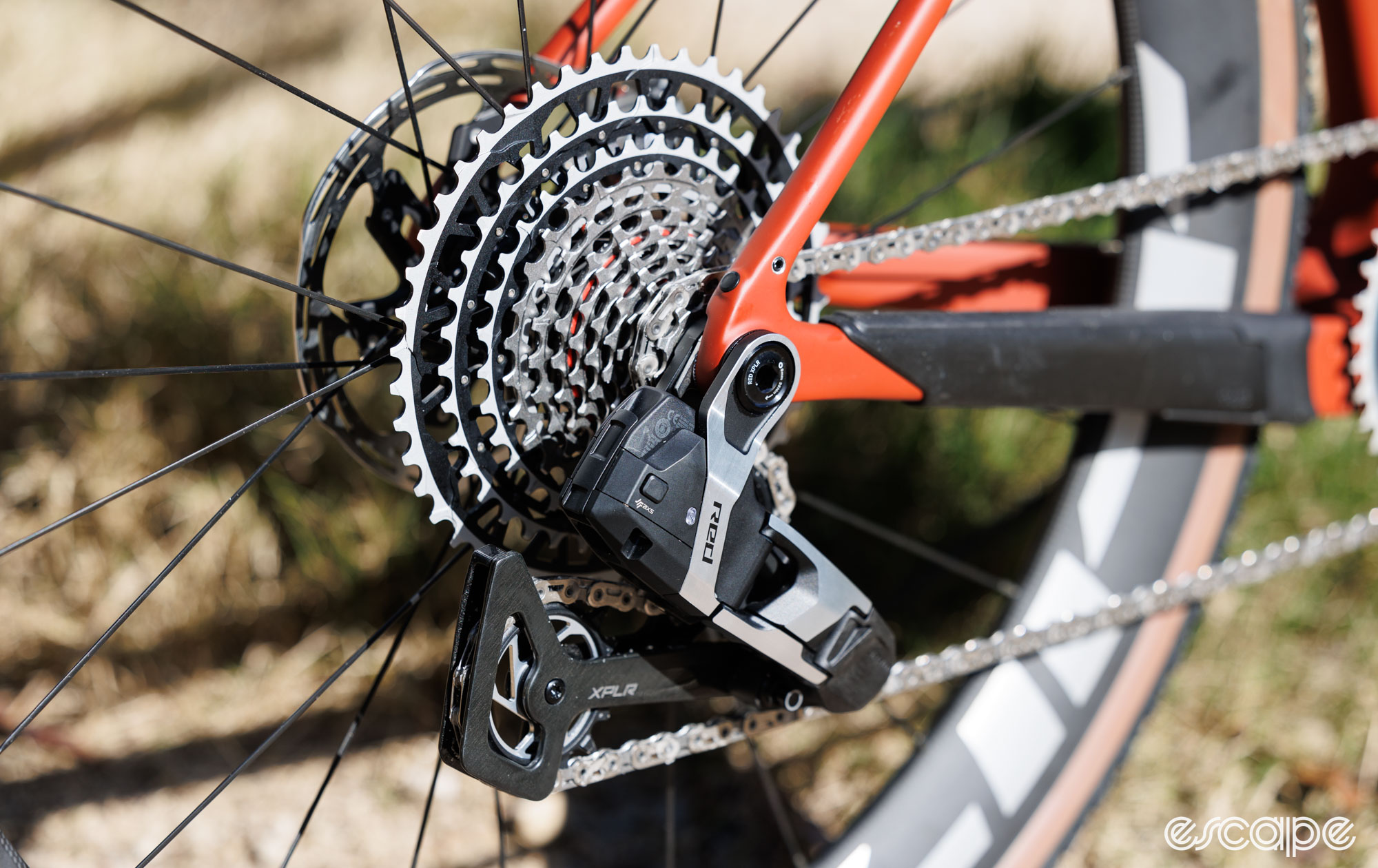
Subtle differences continue with the spring-based clutch mechanism (for chain retention) being similar to what’s found in Transmission derailleurs, but with a lighter spring for efficiency gains and reduced weight. Still, SRAM claims this offers better chain retention than anything it's previously made, excluding Transmission, of course. The aluminium body of the derailleur is further lightened compared to the mountain bike offerings, and the full carbon cage assembly is shorter (by approximately 10 mm, measured from the Full Mount/dropout). However, it’s still fairly enormous when you put it side-by-side with a previous 1x12-speed XPLR rear derailleur.
An old demo of some of the features in Transmission that are now shared in Red XPLR AXS.
Other elements are identical to Transmission. The battery remains the same as all other SRAM wireless derailleurs (and droppers posts and Flight Attendant suspension). The entire pulley cage assembly and accompanying clutch still screw into the derailleur body without tools, making future replacements an absolute breeze. The battery clip and outer parallelogram plate remain replaceable parts in the event you do something horrific. Borrowing from the latest GX Transmission derailleur, the battery also sits in a better-protected horizontal position. The oversized pulley wheels (16T lower) are identical to those used in the XX SL derailleur. And as shown in the video above, this includes the “Magic Wheel” feature that allows the chain to keep moving in case a stick finds its way through the open pulley. And there’s still the cage lock for simple wheel removal without a fight with the derailleur’s clutch.
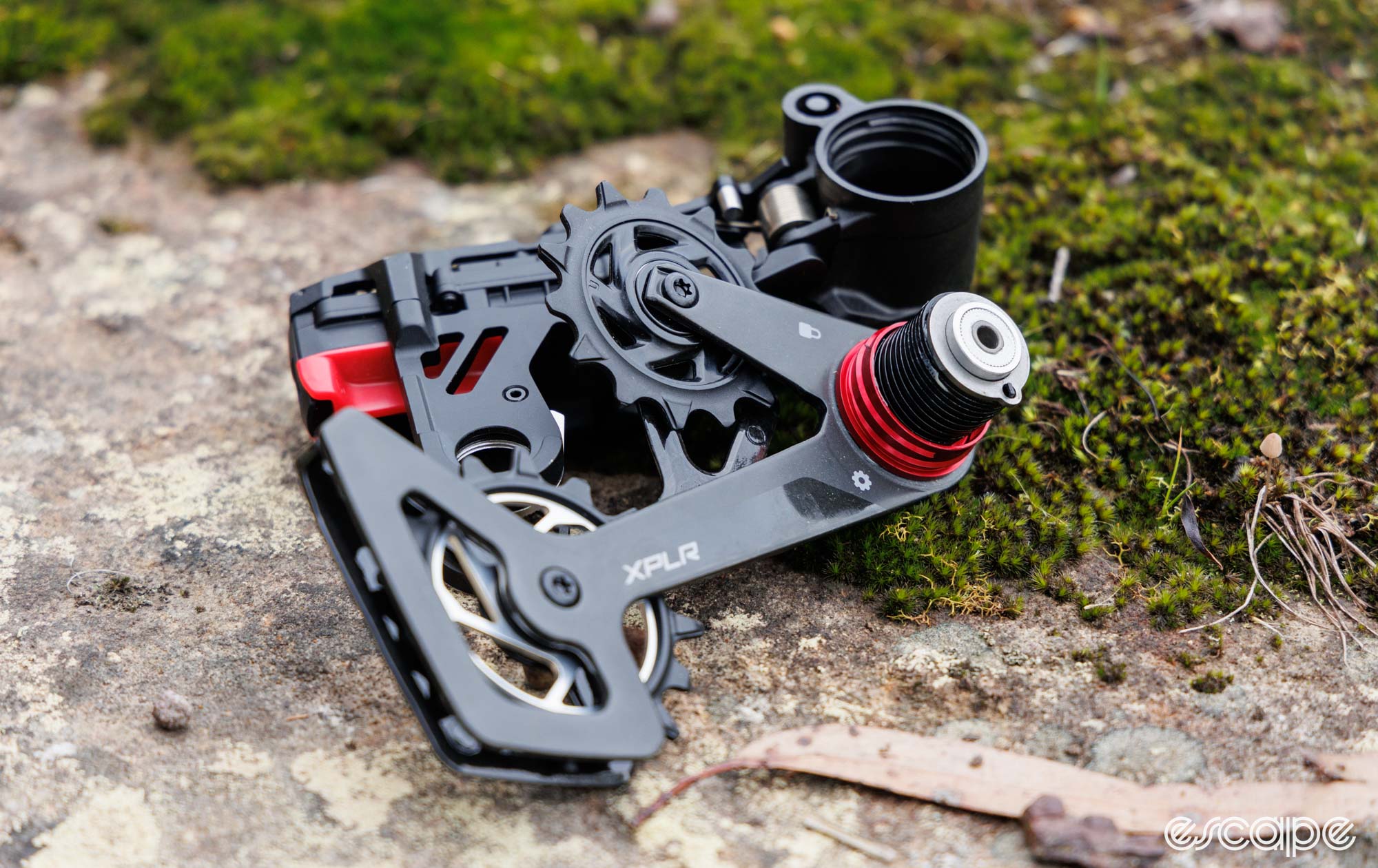

Moving away from the derailleur, the crank arms may be the same as the recently released Red AXS road, but the powermeter is most similar (although not identical) to SRAM’s XX SL mountain bike offering. With this comes great news in that the single chainring is not an integrated piece of the power meter (unlike the 2x road power meter), but rather is fancily threaded into place. Just like the XX SL system, the “Threaded Mount” is an incredibly neat and reliable connection between the power meter and chainring, with the only obvious downside being that a special tool is needed (or at least strongly advised) to replace the ring.
The threaded design of these rings is proprietary to SRAM with 38, 40, 42, 44, and 46T sizes available. Given the accompanying chain is shared with 12-speed groups, this power meter and chainrings will work with previous XPLR drivetrains, too (assuming that 47.5 mm chainline is appropriate). The powerhouses wanting something bigger than 46T will need to look to SRAM’s Aero rings (with or without power) from Red AXS which can be bolted straight to the XPLR crank. And those on bikes with less than 415 mm chainstay lengths will need to stick with the more integrated 1x crankset options from SRAM’s road options.
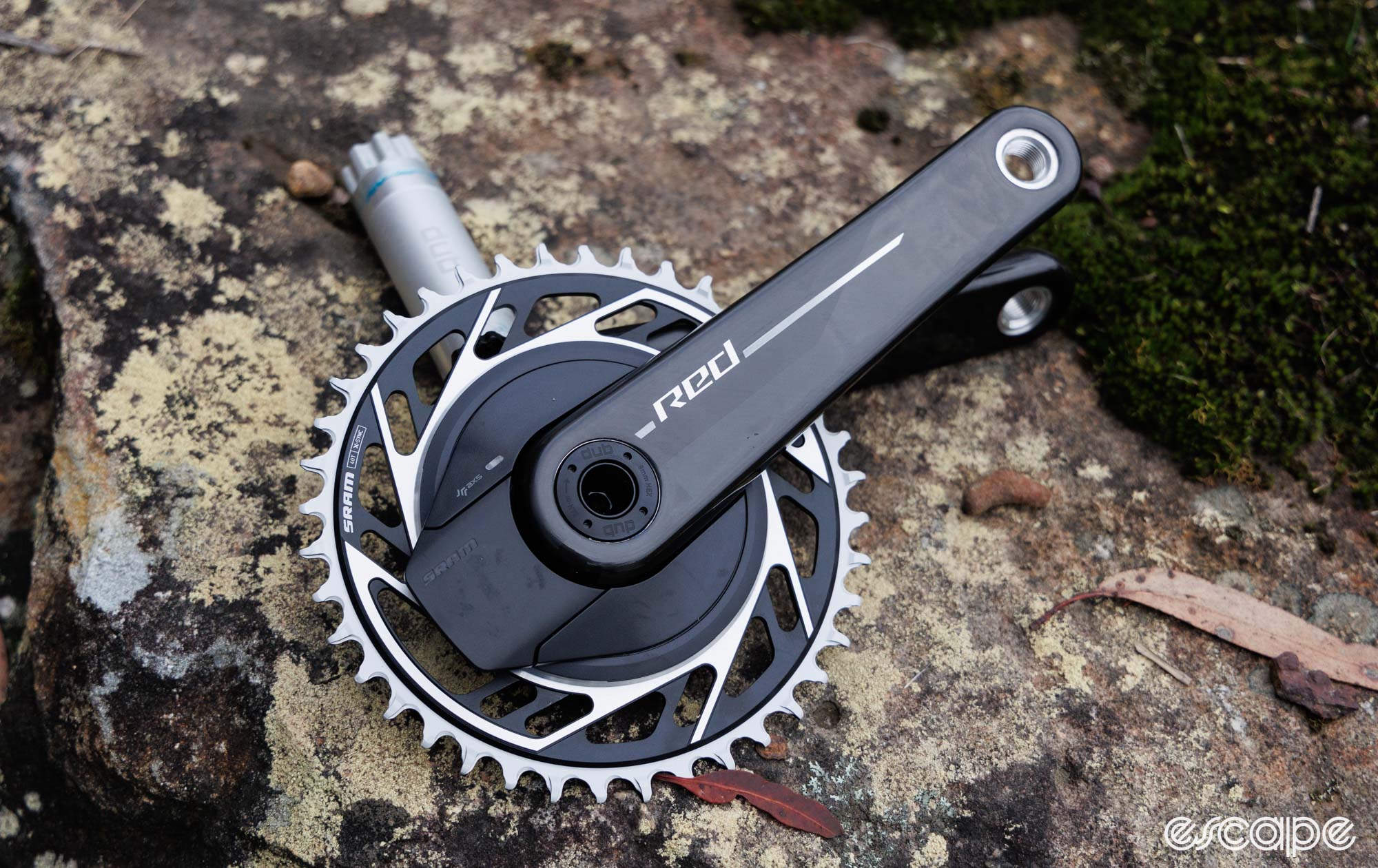
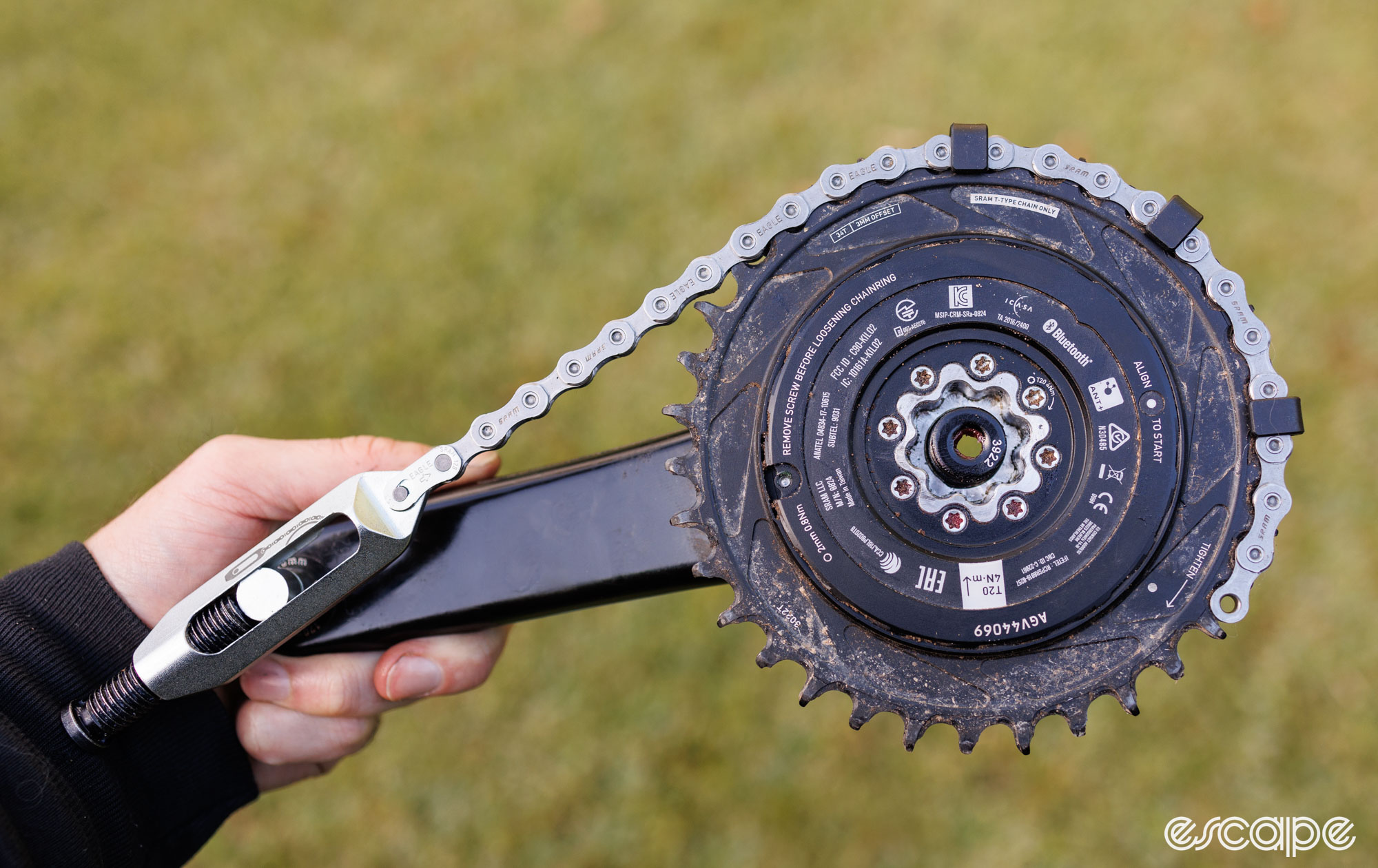
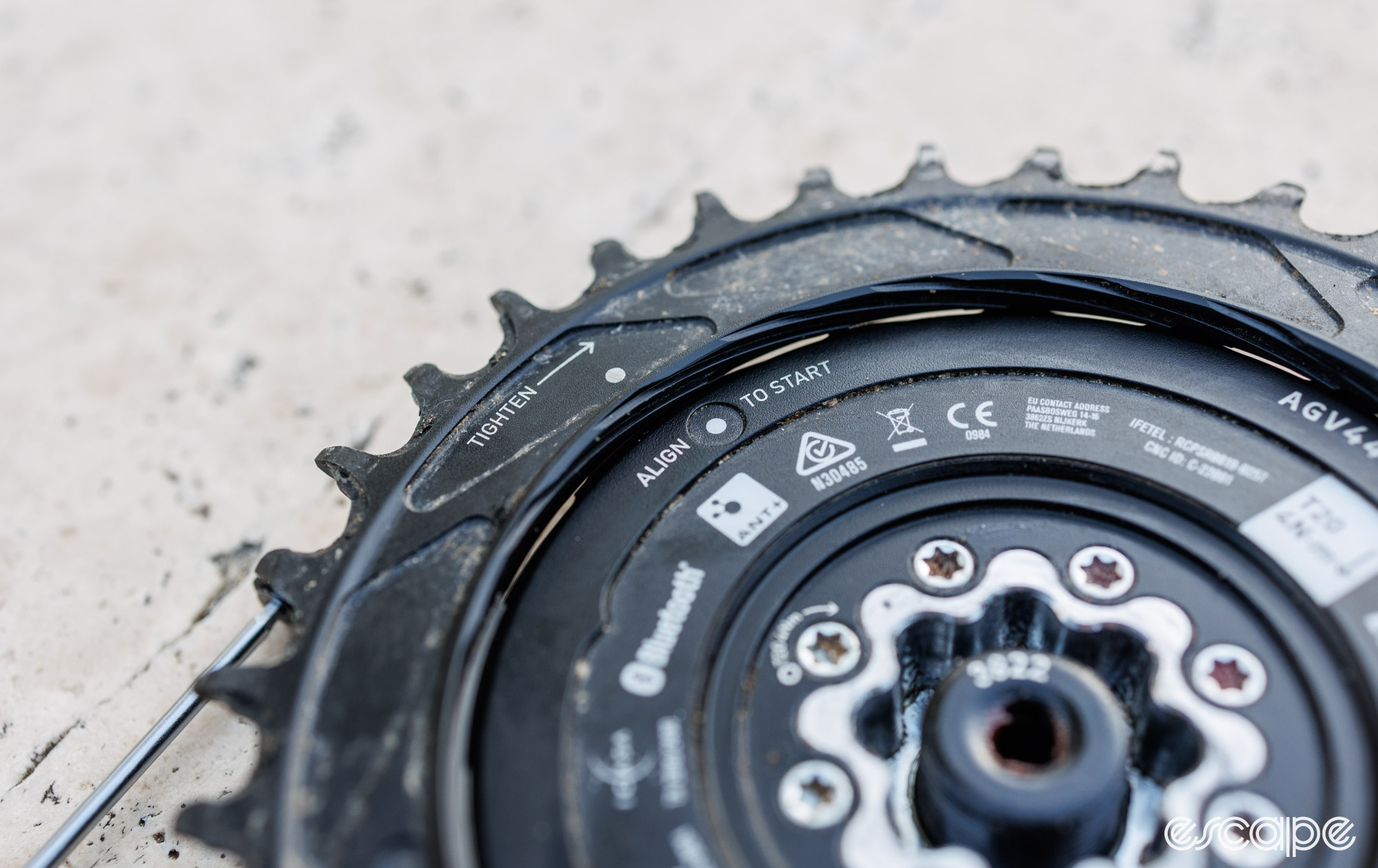
New for the gravel side of things
So far it sounds like the new Red XPLR AXS is made up of a bunch of borrowed parts and ideas, but there are some important differences at play.
Of course, that 13-speed 10-46T cassette is new. It increases the total range of XPLR 1x from 440% to 460% while keeping tight steps toward the smaller (harder) cogs. The gear progressions are 10/11/12/13/15/17/19/21/24/28/32/38/46T, with the goal of more closely mimicking the benefits of 2x groups when rolling in a group at higher speeds. Compared to the previous XPLR, SRAM has merely added the 12T cog and upsized the 44T.
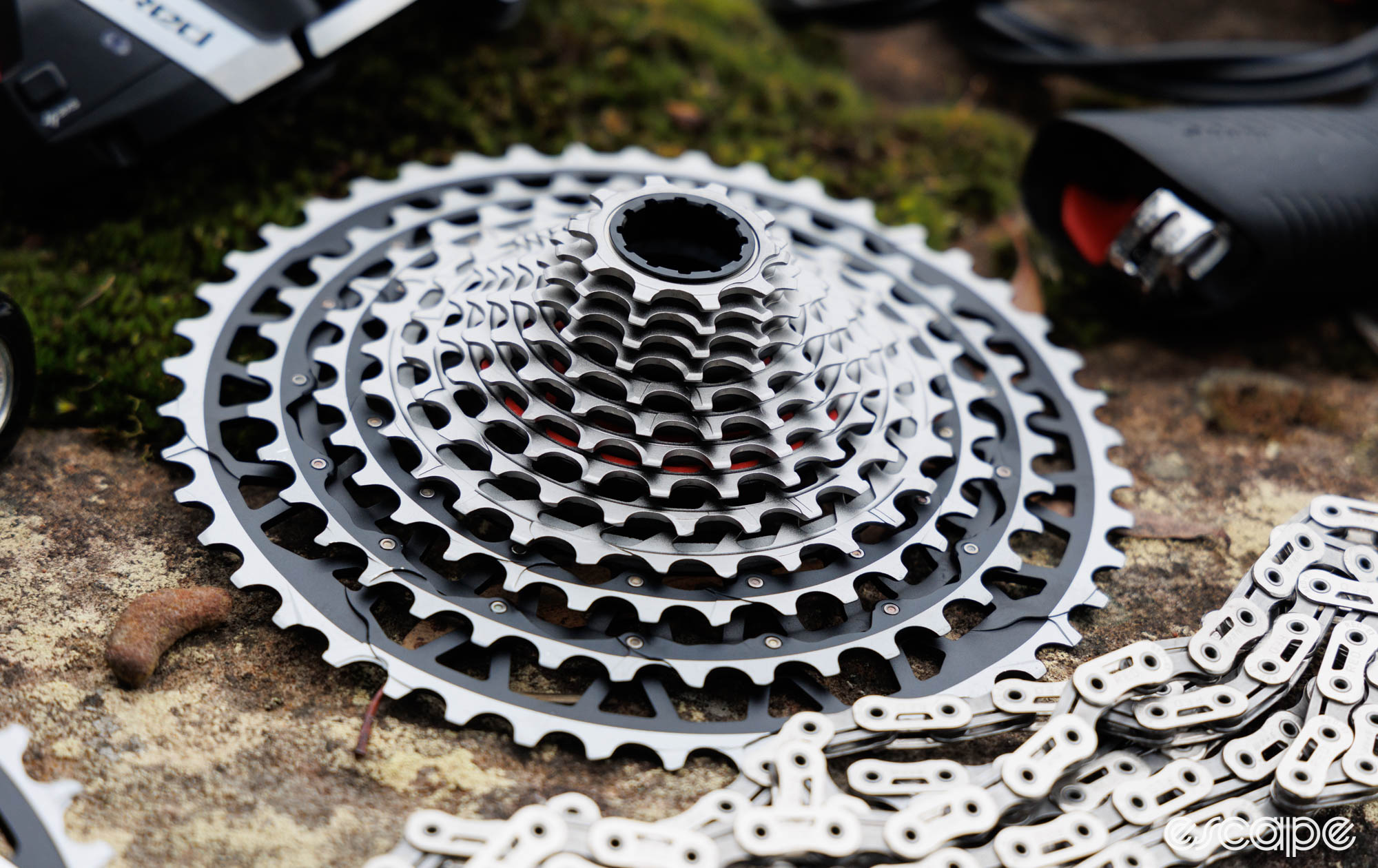
One of the complaints I often shared in relation to 12-speed XPLR is that the 10-44T cassette range felt limited when riding rough and steep gravel where traction is scarce. It was enough for faster and flatter gravel, but not so much for adventure-style riding. For more variable terrain, on a more capable gravel bike, or perhaps if carrying the weight of bags, then SRAM’s 10-52T Eagle option with its 520% total range is often the better choice. SRAM also continues to offer 2x drivetrain options, with up to 516% total range on offer there. By comparison, Shimano’s latest GRX 2x12 Di2 groupset offers up to a 508% total range, while its GRX 1x12 mechanical groups can be configured with either 450% or 510% total ranges. And then there’s Campagnolo Ekar, which offers up to a 467% range (9-42T cassette)
Still, I was curious how the new XPLR, with no apparent limitations on the range SRAM could choose, settled on 10-46T.
“When we launched XPLR [ed. 10-44T], with the possibility for Mullet [ed. 10-50T], our biggest cassette was 10-33. The feedback was 10-50T was just too big for gravel demands. Feedback from riders and racers was to land on something in the middle,” said SRAM Product Manager JP McCarthy (who makes these exact decisions in the gravel product segment). “10-44T was the outcome due to some derailleur limitations at the time.”
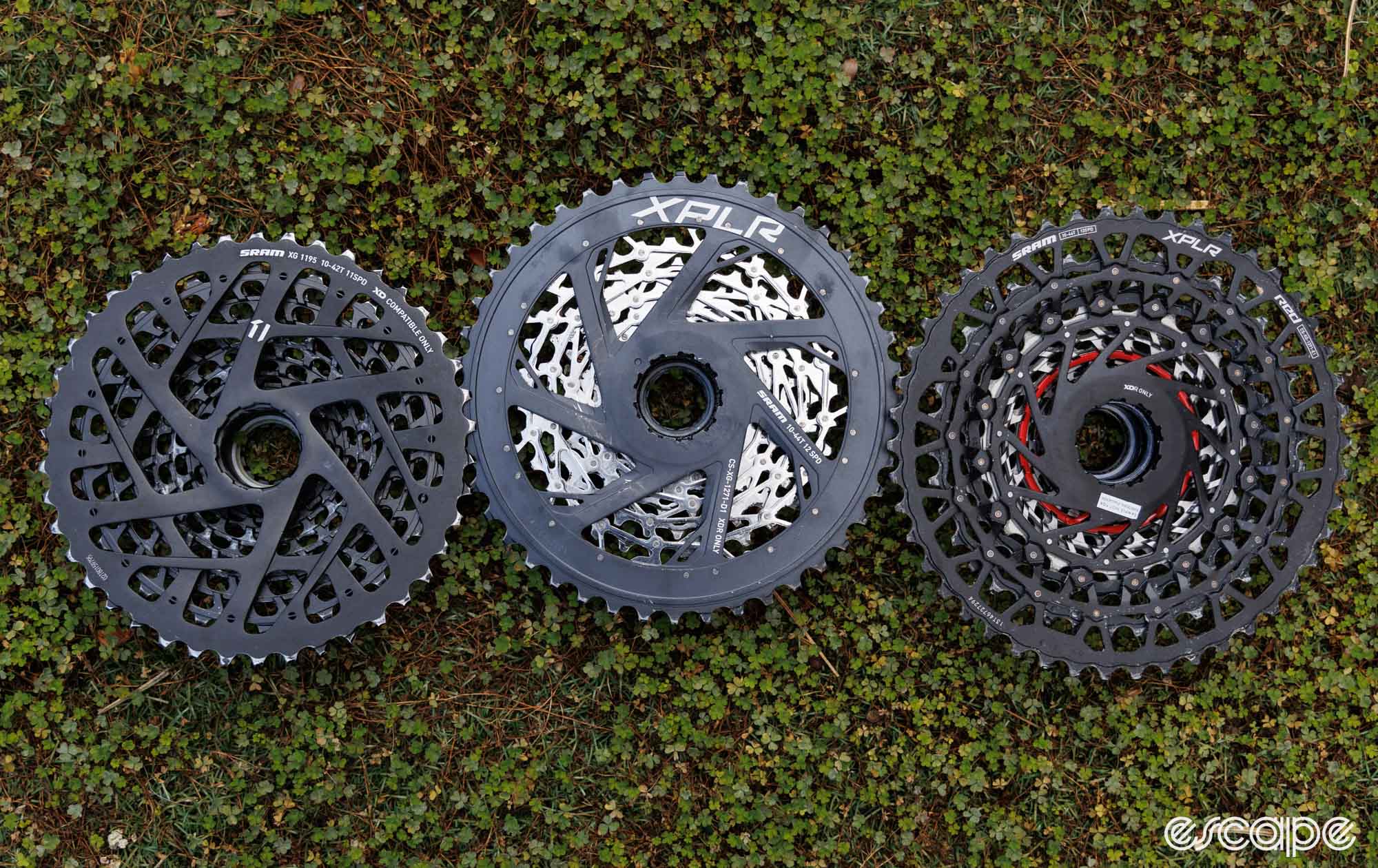
Now with the derailleur capacity no longer a limitation, SRAM added just marginally more range. “There’s no science to say this is the perfect range, so we have rider choice,” said McCarthy in reference to the ability to run a ‘Mullet’ groupset with a 10-52T cassette or use a 2x drivetrain. McCarthy also noted that its “spec count data” (effectively original equipment demand) has shown approximately 15% of gravel bikes to use 1x mountain bike gearing (10-50T or 10-52T), 30% are still equipping 2x (popular in Europe, but declining), and the remainder equipping a tighter 1x range with XPLR.
It’s the first time SRAM has done a Red-level XPLR cassette (the previous D1 version was a Force-level cassette), and with that, it’s significantly lighter than the 12-speed version it supersedes. The cassette construction is most similar to Eagle XX SL Transmission, with the three biggest cogs being machined from aluminium and bolted to a machined block of steel cogs. Compared to SRAM’s X-Dome cassettes on the road, this arguably reduces material waste, and not being hollow, it also runs quieter.
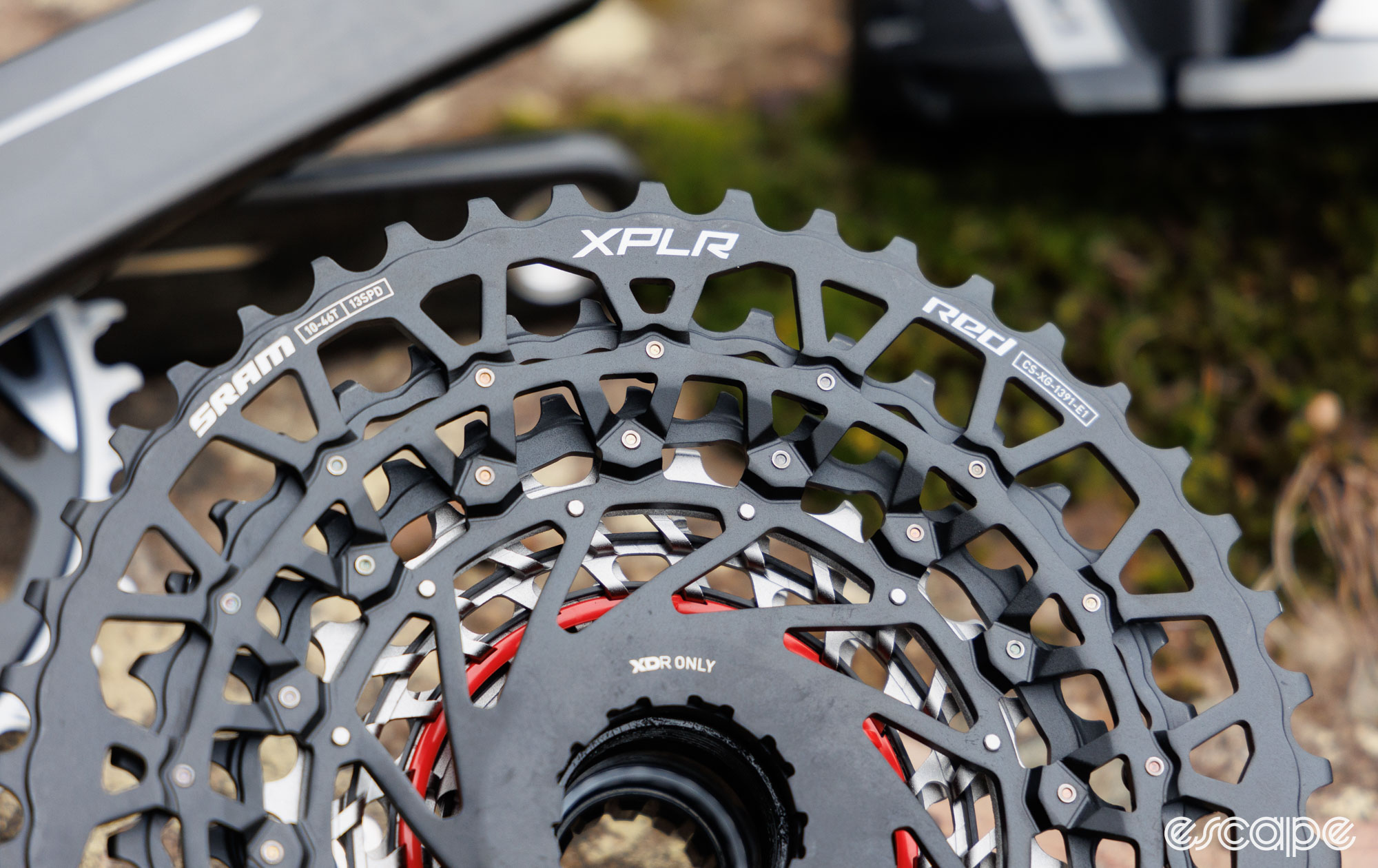
There are no changes to what the cassette attaches to, with SRAM’s XDR freehub system continuing unchanged from when the company first went 12-speed on the road. Compared to the original XD system (still used for mountain bikes), the “R” in the XDR design stands for “Road” and is 1.85 mm wider to afford more cassette space. Everyone, except Shimano, now offers its road/gravel hubs with the option of a XDR freehub.
Where SRAM’s Transmission drivetrain prioritises shifting under full power (mostly with e-bikes in mind), new XPLR rather prioritises shift speed. Allow me to explain.
The most common complaint associated with SRAM’s Transmission shifting is the controlled shift speed. Transmission does this as high-powered eMTBs (electric mountain bikes) can have riders regularly shifting with an excess of 1,000 watts going through the chain. Shifting across multiple gears under such demand can quickly lead to broken chains and cassette teeth. To avoid this, SRAM introduced a narrow-wide profiling to the cassette teeth that kept the chain strongly engaged as it was shifted between two cogs. They then devised a derailleur that was digitally mapped to the cassette in order to know when it could safely make each shift and have it hit the mark. It works remarkably well and sets a new benchmark for shifting under power, but by waiting for one shift to fully complete before it allowed another, it has become a polarising option for anyone wanting to make multiple gear changes in one swoop.
By contrast, the new Red XPLR AXS doesn’t have the narrow-wide profiling on the cassette teeth, nor is the derailleur as smartly mapped. Instead, the XPLR system is free to shift multiple gears as quickly as the servo motor allows. Shift speed is approximately the same as Red AXS road (when set up as 1x), and marginally quicker than Red AXS road in a 2x configuration. While it’s not quite as quick as Shimano Di2, it’s arguably still plenty fast.
Backward compatibility
When SRAM announced the new SRAM Red AXS road in May of this year, one of the key features was complete backward compatibility with the previous (and current) generation AXS road components. Some of that remains true with the new Red XPLR AXS, and in terms of new fitment requirements, the only significant caveat is needing a frame with a UDH. SRAM offers a list of frames if you're unsure.
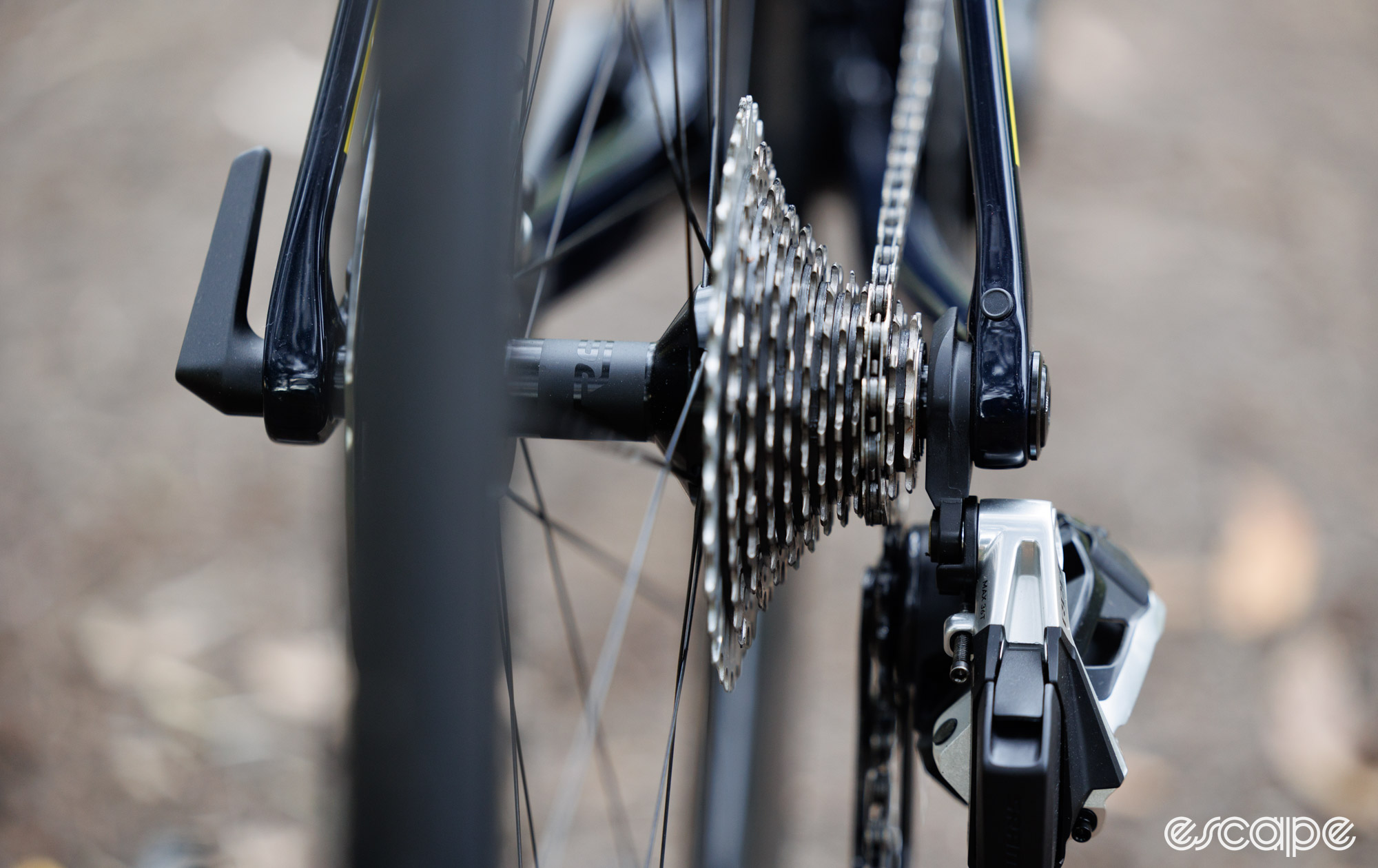
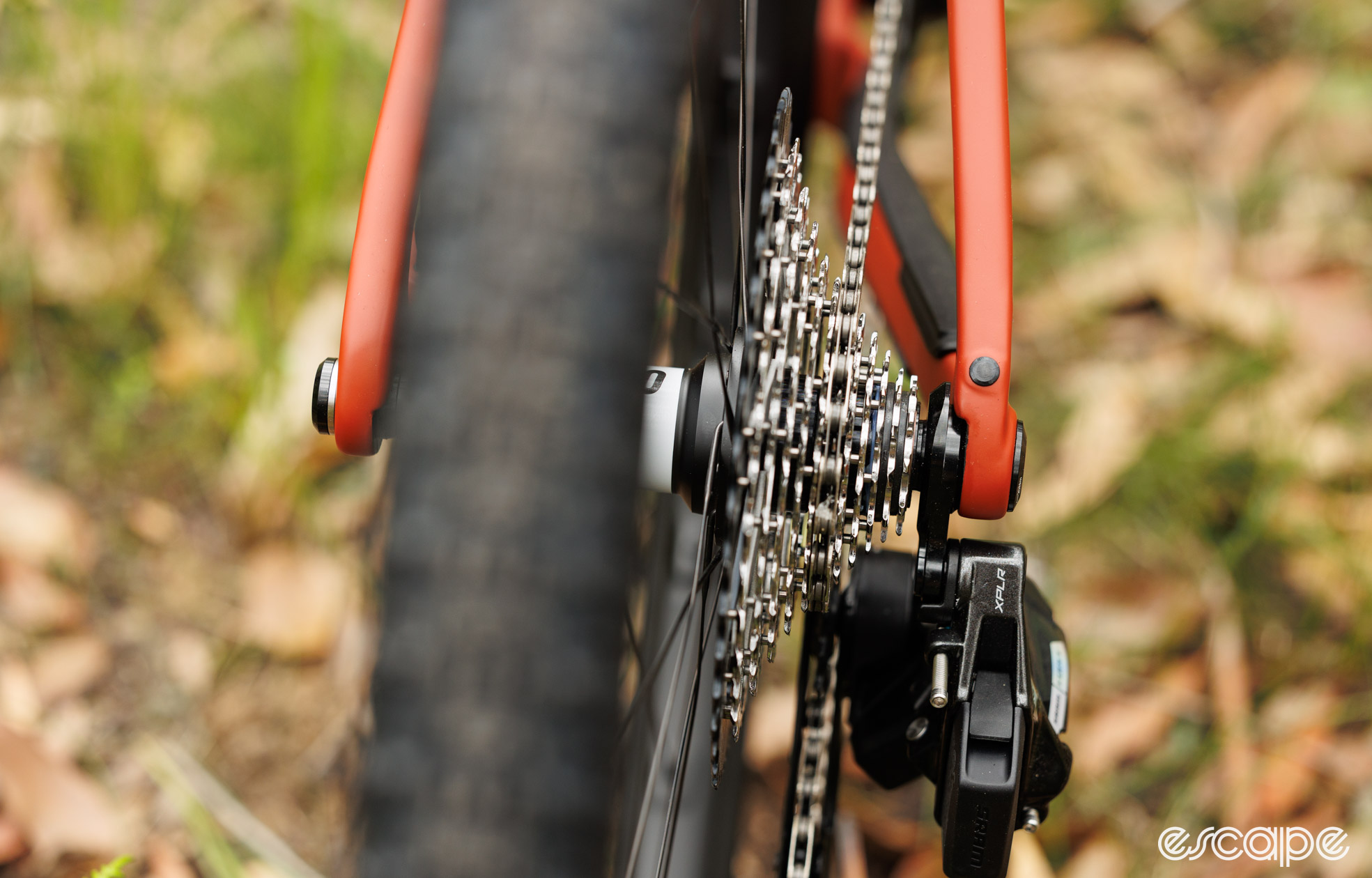
SRAM has done an impressive job of building out its AXS ecosystem of components to be almost entirely cross-compatible. Want to run a pair of pre-existing AXS shifters/brakes with the new Red XPLR derailleur and 13-speed cassette? Go for it. Want to use the new Red AXS shifters and brakes with a Transmission mountain bike derailleur and 12-speed 10-52T cassette? Yep, do it. Just about everything that carries the AXS name will communicate with another AXS component.
If you’re an early adopter and already own a UDH-compatibile frame then you have all the options. You can match the new shifters, brakes, and power meter to either an XPLR (10-46T) or Transmission derailleur (10-52T). Or you can also place a more traditional derailleur on the UDH derailleur hanger.
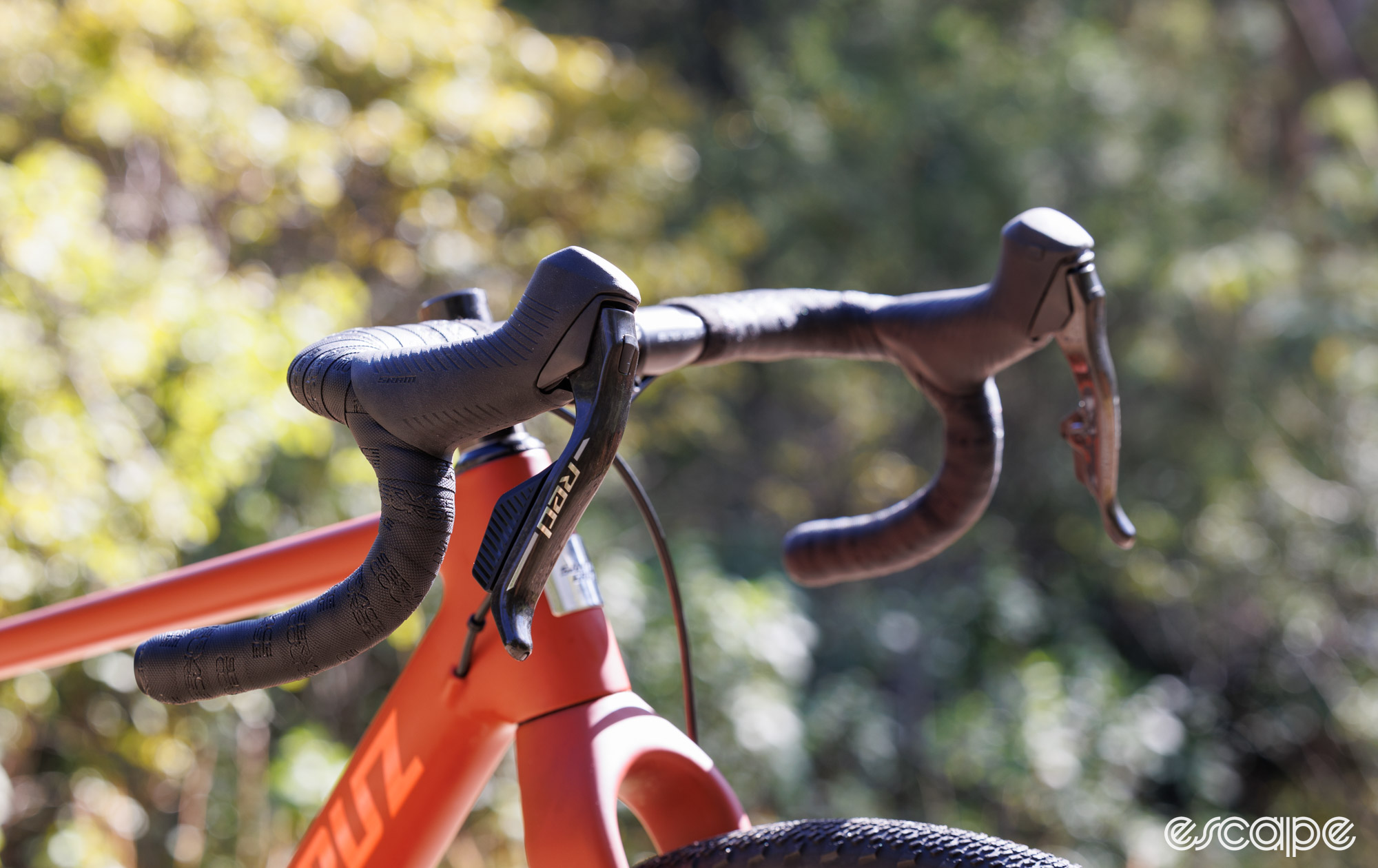
Those without a UDH-compatible frame (aka, most dropbar bikes) won’t be able to use the new Red XPLR Full Mount derailleur or 13-speed cassette, but you still have an overwhelming number options from SRAM. You can use the pre-existing 1x12-speed XPLR derailleur and accompanying 10-44T. You can use the new Red AXS road stuff, either in 1x or 2x (10-36T cassette, max). Or you can get a Eagle AXS mountain bike derailleur for a 1x12 setup with a 10-52T gear range. And again, you can do all that with the greatly improved shifters/brakes and new powermeter from Red XPLR AXS.
Weights and pricing
All of these updates also claim a 102 g weight saving compared to the previous generation of Red XPLR. Without a front derailleur, it’s also lighter than the new Red AXS 2x. SRAM claims a complete Red XPLR AXS groupset weighs 2,476 g.
As with the new Red AXS road group, a bunch of those grams saved come from the new lever and brake assembly that drops 83 g. The new lightened crank arms save a further 30 g, and the new cut-out-plates in the chain save 13 g.
That leaves just the derailleur and cassette. Compared to the previous XPLR, the new derailleur looks like it’s been injecting in a bathroom stall at the local bodybuilder gym – it’s comparatively massive. The new Full Mount derailleur weighs an actual 379 g (without battery), while a previous-generation SRAM Red XPLR D1 derailleur tips the scales at 323 g (including the UDH at 27 g). The new Red XPLR derailleur is 32 g less than its XX SL Transmission counterpart.
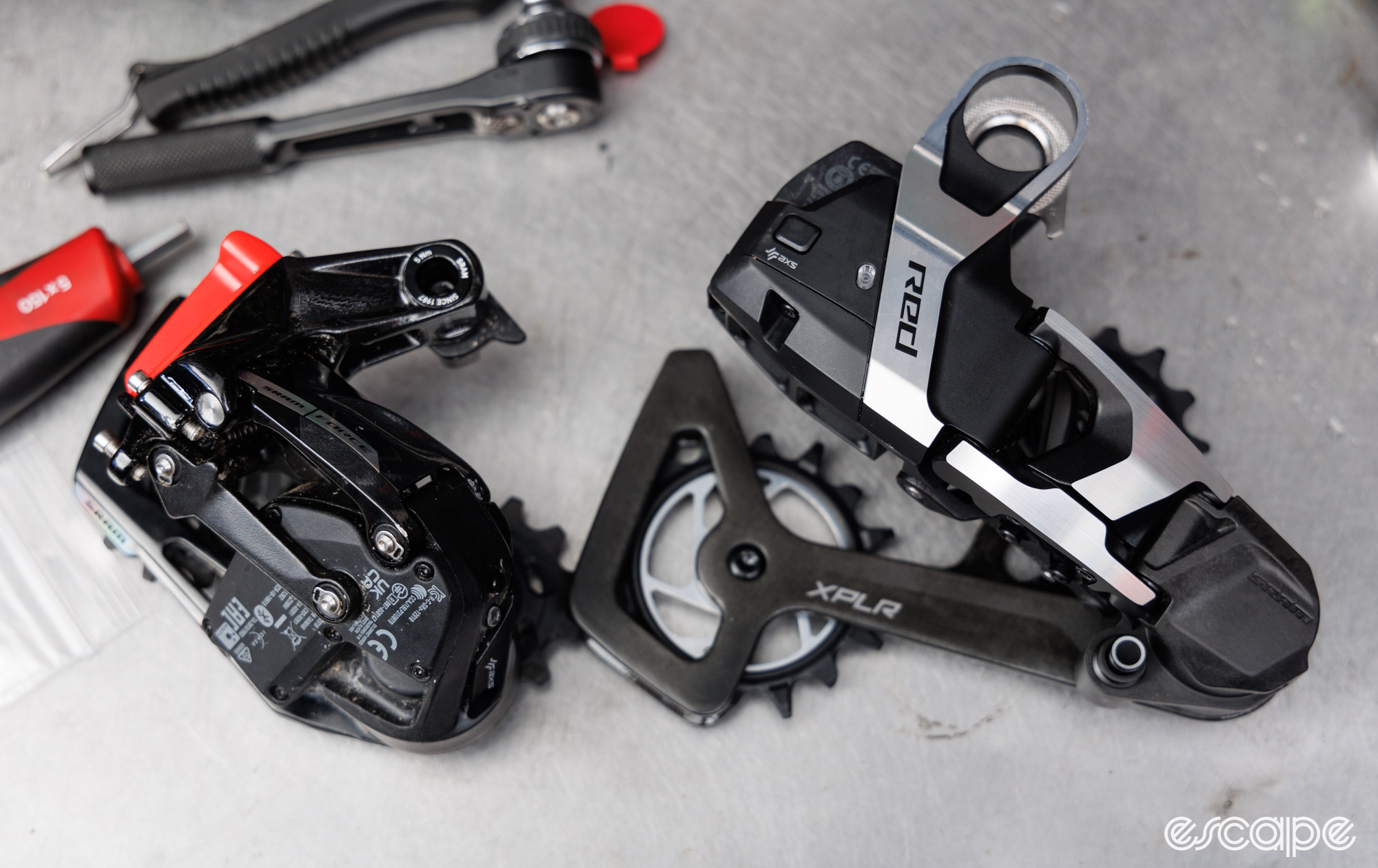
As for the cassette, I weighed my test sample at an impressive 288 g. By comparison, the 12-speed 10-44 XPLR Red/Force cassette weighs 379 g, while a 10-52T XX SL Transmission cassette is 347 g.
Actual weights:
- Rear derailleur: 379 g (with hardware)
- XG-1391 Cassette: 288 g
- Crankset (170 mm, 40T chainring, power meter): 506 g
- Right crank arm, with power meter and 40T ring: 335 g
- Shifter, left: 205 g
- Shifter, right: 204 g
- Brake caliper and hose, front: 150 g (with pad spacer)
- Brake caliper and hose, rear: 164 g (with pad spacer)
- Paceline X rotor, 160 mm: 133 g, each
- Chain: 250 g (122 links)
This is not cheap stuff. Most of the pricing is directly in line with Red AXS road, with the single-ring cranks being a little less and the wider-range cassette jumping up to a figure that’ll have you wincing at the sight of mud. If there was ever a cassette to have you reconsider your chain maintenance and lubing methods in order to improve durability, this is it. Sheesh.
| Part | USD | Euro | GBP | AUD |
| Red XPLR XG-1391 cassette | $600 | €675 | £600 | $1,030 |
| Red chain | $89 | €100 | £90 | $155 |
| Red XPLR AXS rear derailleur, without battery | $700 | €785 | £700 | $1,205 |
| Red AXS shifter, brake caliper, and hose, left side | $675 | €755 | £675 | $1,160 |
| Red AXS shifter, brake caliper, and hose, right side | $675 | €755 | £675 | $1,160 |
| Paceline X disc rotor, each | $70 | €80 | £70 | $120 |
| Red XPLR crankset with power meter (single ring) | $1,100 | €1,235 | £1,100 | $1,890 |
| Red XPLR crankset with no power meter (single ring) | $650 | €730 | £650 | $1,115 |
| Chainring, Thread Mount for power meter | $150 | €170 | £150 | $TBC |
All told, a complete groupset with the power meter costs approximately US$3,980 / €4,465 / £3,980 / AU$6,840, or US$3,530 / €3,960 / £3,530 / AU$6,065 without power.
Installation
There have been a lot of numbers to take in with this new release, but to refresh your memory, the new Red XPLR AXS requires a frame with a UDH mount. It’s for frames with a 142 mm rear axle width and needs a wheel with an XDR freehub body. It can fit road bikes with chainstay lengths between 405-415 mm (the new Trek Madone being one example already in market), but then requires the use of a road 1x crank with a 45 mm chainline. For bikes with 415 mm chainstay lengths or longer, you’ll need a 47.5 mm chainline (provided by the matching XPLR crank).

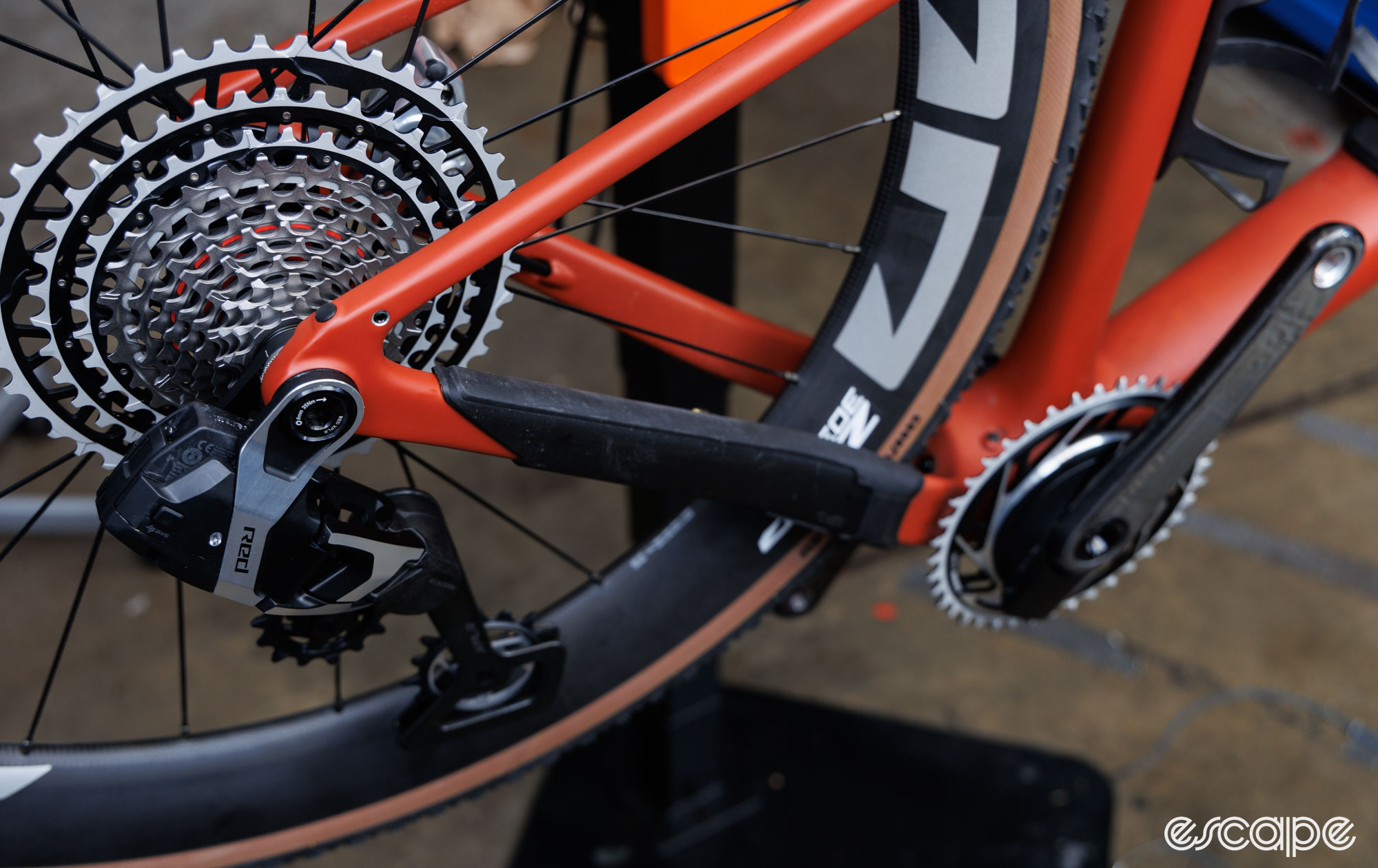
Like Transmission, the new Red XPLR derailleur lacks any limit screws or B-tension bolt. Rather, the upper and lower derailleur limits are set based on the Full Mount derailleur design, while the equivalent of B-tension (how far the upper pulley sits from the cassette) is controlled by locking you into a single cassette size and then calling for a specific chain length and installation process.
The three-step install process, covered previously in my review of XX SL Transmission, is very different from other derailleur systems but is arguably also simpler and easier. SRAM takes the guesswork out of chain length by calculating it based on chainstay length and chosen chainring size and then telling you exactly how many links to remove from a new chain. The XPLR derailleur also lacks the Flip Chip B-gap adjuster found in the Transmission derailleur, so there’s one less step there, too.
There are a few specific steps to follow, and using a torque wrench is strongly advised, but it’s arguably the easiest and fastest drivetrain to install on the market. By far, the most skill-intensive part is trimming the hoses and bleeding the brakes, but even that is arguably the simplest with SRAM.
You don’t need SRAM’s brilliant AXS phone app to do the install, but home mechanics are sure to appreciate it. It’ll walk you through the chain sizing, derailleur setup, wireless component syncing, and can even be used to micro-trim the position of the derailleur (like you would with a barrel adjuster on a mechanical setup) in case of chain rasping noises.
There are also no new tools required to install or service this new groupset, and it’s all largely handled with a few hex keys and a T25. However, there is that special chainring tool for the Threaded Mount power meter.
How it all performs
I’ve spent the past few weeks riding and testing this new stuff, and while that’s not a long period of time, I am comfortable providing some conclusions. Those conclusions are possible through SRAM’s repurposing of parts and concepts from other groupsets that I have extensive experience with. I’ve used SRAM’s mountain bike Transmission systems across a number of bikes since early 2023. The cranks, shifters, and brakes are all things I got to know well over the past few months with the new Red AXS road groupset.
I didn’t attend a launch event for the new Red XPLR; rather SRAM sent me a box of parts and a link to the manual. From there I had the freedom to build it up into a bike, get a feel for how it all goes together, and then freely test the components on familiar terrain with a familiar bike.
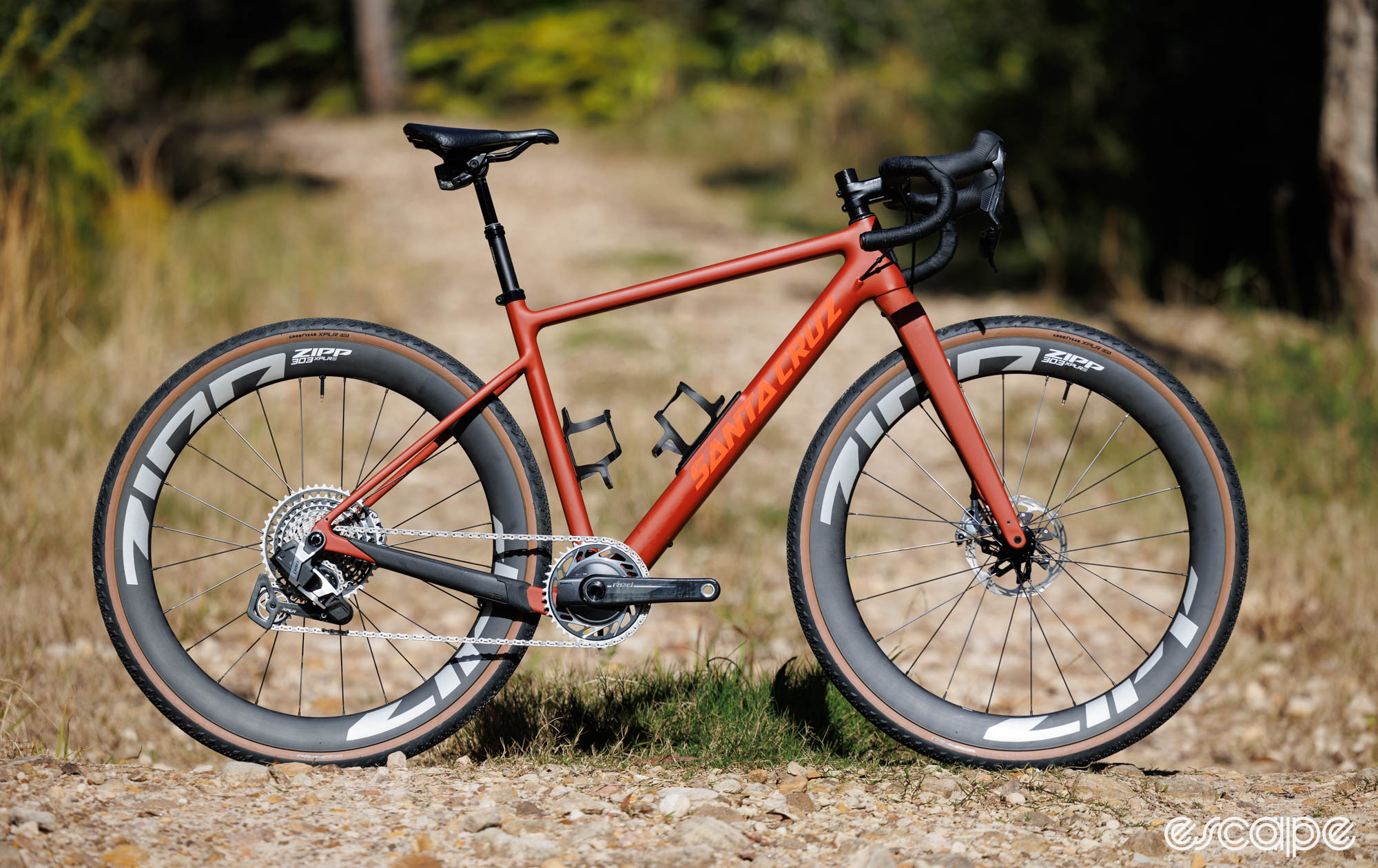
The instant sensation is how unsurprisingly familiar it all feels. Those newly overhauled shifters have been widely met with praise for feeling natural in the hand, supportive, and with increased button options. The hood covers themselves provide an impressive balance of grip without grating skin if riding without gloves. The swept shape of the brake levers is right on trend with flared bars. Just beware, the new hoods are longer and so your effective reach will grow by approximately 5 mm.
More praise continues in the brake lever feel, which is simply night and day better in terms of effort required to get the lever moving and effort required to control speed. SRAM’s previous dropbar brakes can often feel vague, and they can need two fingers for control when things get steep, but the new Red AXS levers really are a one-finger operation (index finger).
As called out in my Red AXS road review, I do find the new levers to have a bit too much freestroke (lever movement before pads engage) for my liking. This is only an issue when running the lever reach closer to the bar, and while SRAM has done well reshaping things to solve for the pinched fingers issue of the past, I’d still like a little less redundant lever travel. SRAM’s provided Contact Point Adjustment doesn’t solve this issue, and adjusting it only offers the option to make the matter worse. Rather, the only solutions I’ve found are old-school ones, involving over-filling the system and/or walking the caliper pistons out so the brake pads run closer to the rotor – it’s a trade-off as then you reduce the otherwise excellent pad clearance.
As with most hydraulic brake systems, the brake pad contact point can suffer as you bring lever reach in.
Still, despite this preference, the light action and well-controlled power of these brakes ensure they remain as a benchmark product.
I had initially expected the shifting to feel similar to Transmission, but really, it feels far closer to SRAM’s road groups. Shift speed still doesn’t match that of Shimano Di2, but it’s marginally quicker than SRAM’s 2x groups and easily quick enough to not annoy. The close ratios toward the outer end of the cassette assist with rapid and well-controlled transitions where you’re likely under stress.
Those who don’t like the shift speed of Transmission will be pleased by the ability to shift multiple gears in one go. Actuating those shifts remains the same since SRAM first went electronic and wireless on the road, with the left lever sending the chain along the cassette in one direction, and the right lever causing the chain to go the other way - what lever does what is your choice.
The shifts also run quieter compared to SRAM’s smaller and hollow road cassettes. SRAM Red AXS can certainly be shifted under high power without fear, and the stiffer derailleur connection seems to make it marginally more positive-feeling than Red AXS road. However, such smoothness under heavy loads is still surpassed by SRAM’s Transmission and Shimano’s HG+ (12-speed).
The gearing range is going to be highly personal and will depend greatly on the type of bike you’re building and/or how you define gravel cycling. I’d long complained that SRAM’s 12-speed XPLR, with its 10-44T range, often felt too limited for the rough-and-steep type of gravel I often find myself doing. The new 10-46T range is certainly better, but for my own gravel riding that involves steep firetrails, double-tracks, and a bit of single track, I still want more. It’s forced me to choose a smaller-than-ideal chainring size (40T) that feels limiting once back on the road. I’m not going to say more is always better, but I’d happily move to a 42T chainring if the cassette featured a 47 or 48T cog.
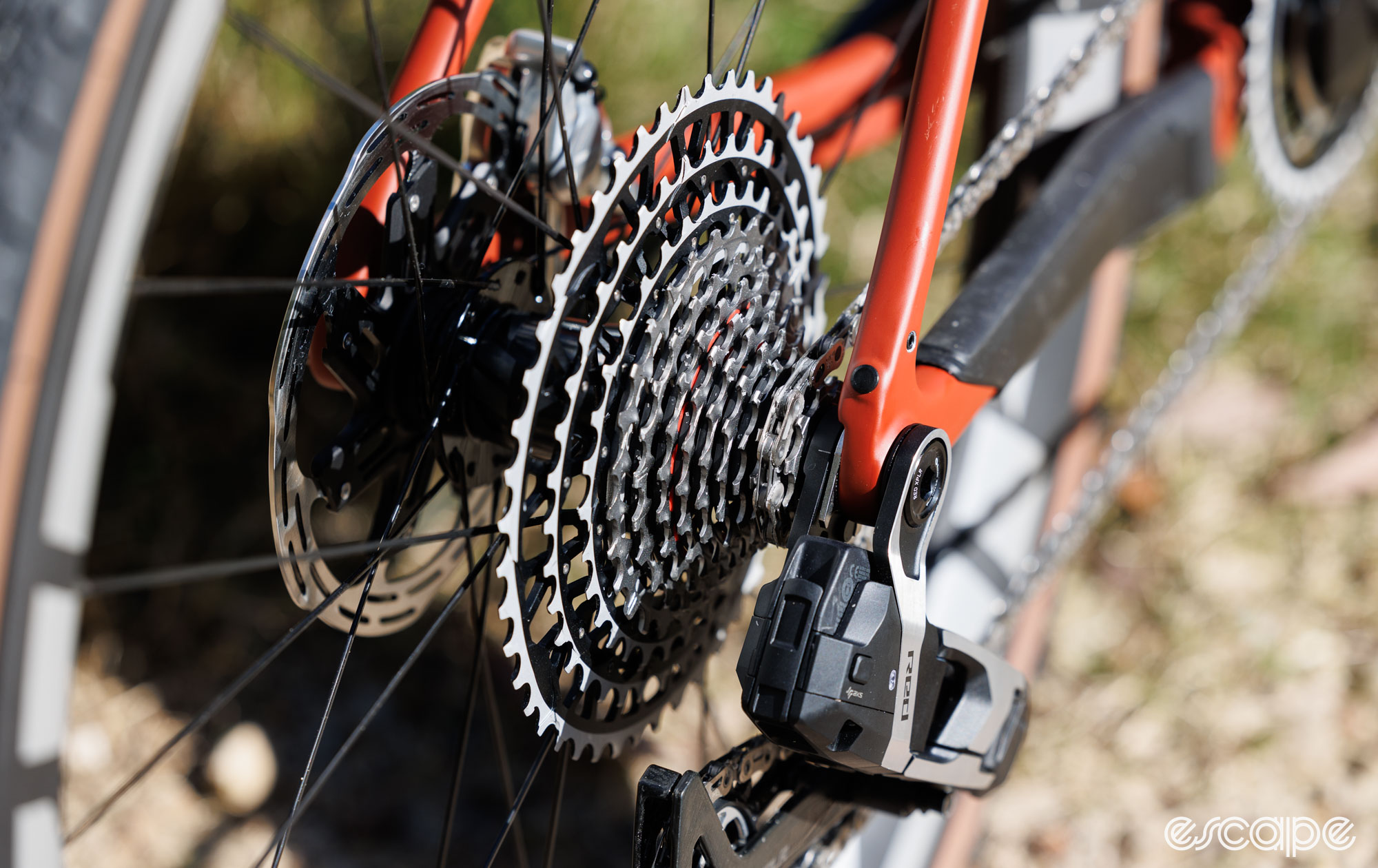
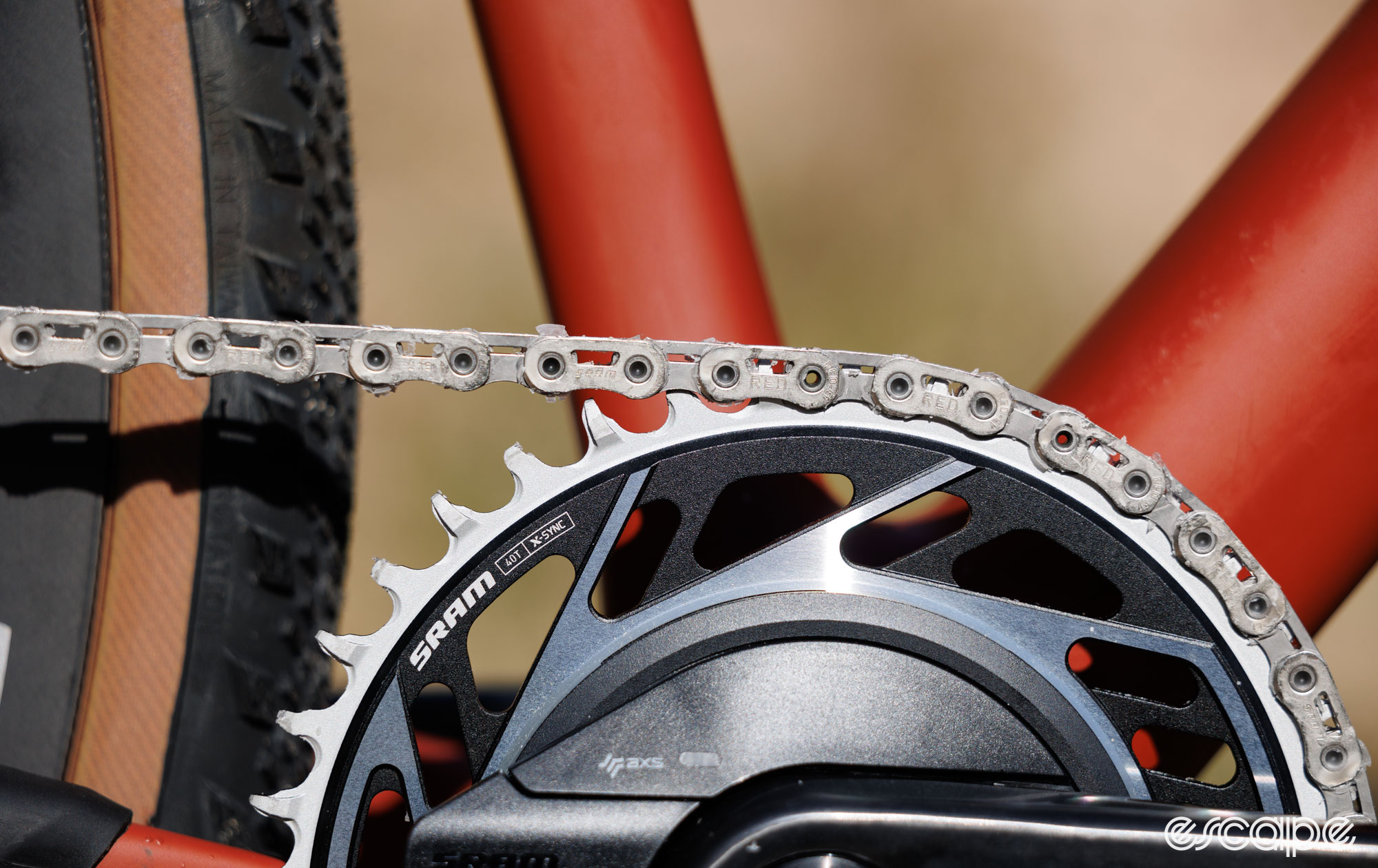
That said, I simply can’t argue with how nice it is to have tight gear jumps when rolling along on the tarmac or fast gravel roads. I do prefer the simplicity of 1x shifting for gravel riding, and so I need to accept such compromises in total range versus close gear steps. If you’re unwilling to compromise and want both tighter gaps and more range, then 2x shifting (which I include Classified’s system within) likely remains the best fit for you. Still, change where I live, the rides I choose to do, or bring back some old racing ambition, and this opinion is sure to change.
When hammering off-road, the more secure clutch keeps the system quiet, and there’s been no inkling of a dropped chain. It’s also great to have SRAM’s Cage Lock mechanism, which lets you lock the derailleur cage in a forward position for easy rear wheel removals or hot-melt chain waxing (not an intended perk, but one that is notable).
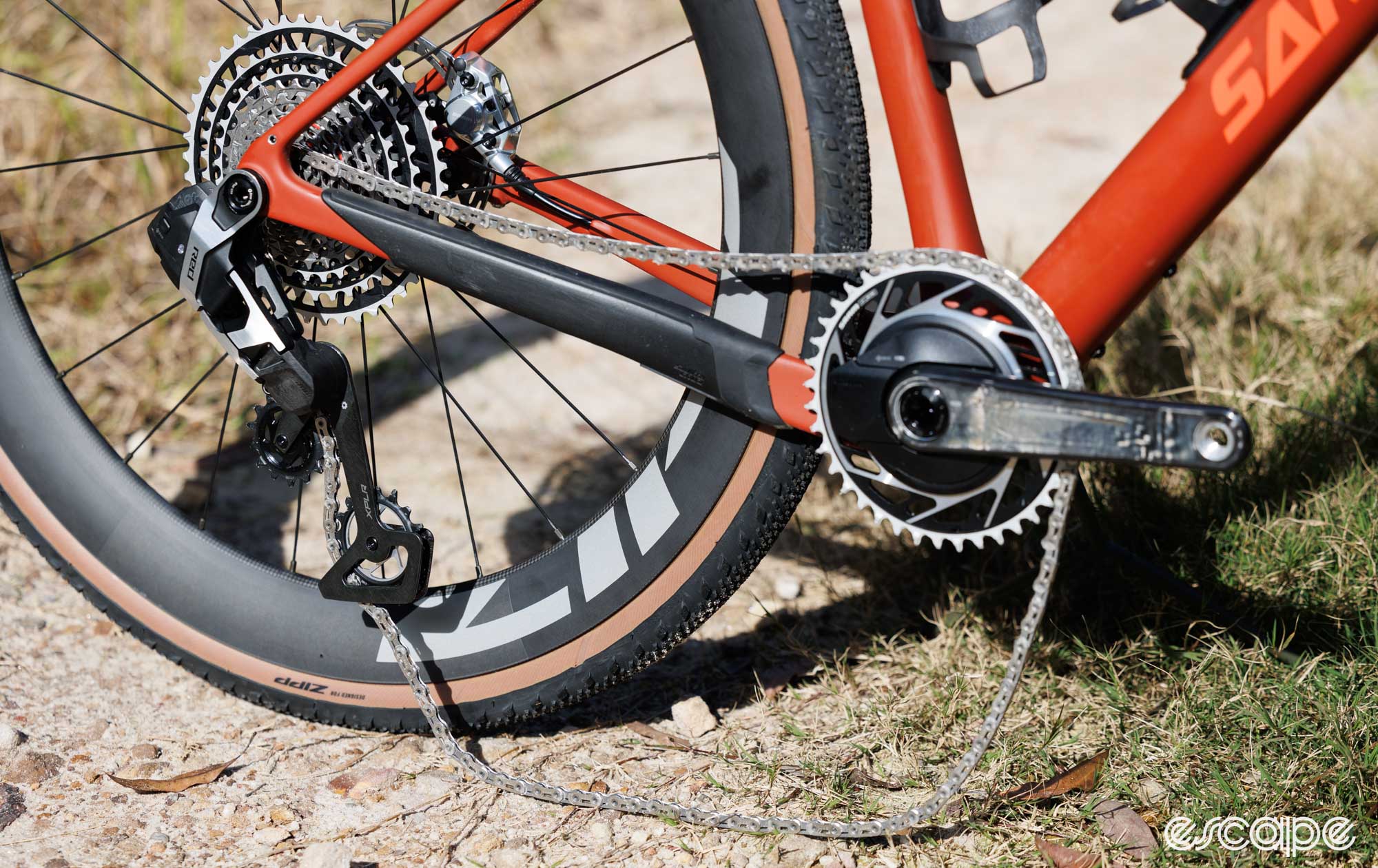
Battery longevity between charges is good, but not Di2-level great. You can expect anywhere from 15-60 hours of riding out of a full derailleur battery and up to two years from the disposable CR2032s in the levers. While for some the derailleur battery may need charging each week, it’s at least incredibly quick to swap and carrying a spare will add just 28 g to your ride. I now have a few AXS bikes on regular rotation and keep a charged battery at easy reach in case I see the red-coloured LED warning of a low battery before I head out the door.
Speaking of things powered by a CR2032 coin cell battery, the spider-based power meter is excellent. It’s an impressively light crank that provides consistent and well-trusted data. While the crank doesn’t officially measure independent left-and-right power, it does a wonderful job of calculating the split. Recent years have proven that SRAM’s (formerly Quarq-branded) power meters are a joy to own.
When Transmission was first released, there were a few falsely held fears surrounding a future of frame failures due to the Full Mount derailleur interface removing the sacrificial derailleur hanger. It’s now 18 months on and Transmission continues to prove itself as a more robust system.
OK, of course it hasn’t been a perfect run. There are rare reports (I've heard of three) of the UDH interface in frames not being manufactured perfectly square to the axle and preventing perfect shifting (a warranty issue with the bike company), and you do hear of the occasional derailleur cage getting killed by trail arrows (sticks). Still, I haven’t come across anything widespread or worrisome related to failed derailleur bodies, frames, or axles. Rather, I see the Full Mount design as positive progress that eliminates the common bent hanger that can quickly lead to damaged wheels, and worse, broken frames.
Past experience and testing done by Zero Friction Cycling has shown that SRAM’s Hard Chrome Flat Top chains set the benchmark for durability. SRAM’s cassettes also fare extremely well in this sense, although do beware that those three largest aluminium cogs will be more sensitive to abrasive wear. Such wear has far more to do with the type of chain lube you use and cleanliness you keep rather the components themselves.
SRAM, Shimano, or Campagnolo for gravel?
SRAM.
OK, let me explain as there are quite a few caveats to such a decision.
Picking this new Red XPLR obviously assumes I have the liberal budget to do so (let’s assume I don’t have a tool-buying problem). It assumes I have a UDH frame (I now do!) ... and I’m happy with the 10-46T gearing range (it’s not ideally suited to my local gravel riding or fitness level).
With an open budget and if I needed a new gravel groupset today, I’d be choosing between this new Red XPLR AXS or a ‘Mullet’ version with SRAM’s Transmission derailleur and 10-52T cassette (which would allow me to size up in the chainring). If I were more honest with myself about my finances, I’d look to splurge on the new Red AXS shifters/brakes and match those to a more attainably priced 12-speed derailleur and cassette, such as SRAM’s Transmission GX derailleur and X01 cassette (due to grams). And if that were still way out of the budget, then I’d be picking Shimano GRX mechanical in a 1x configuration.
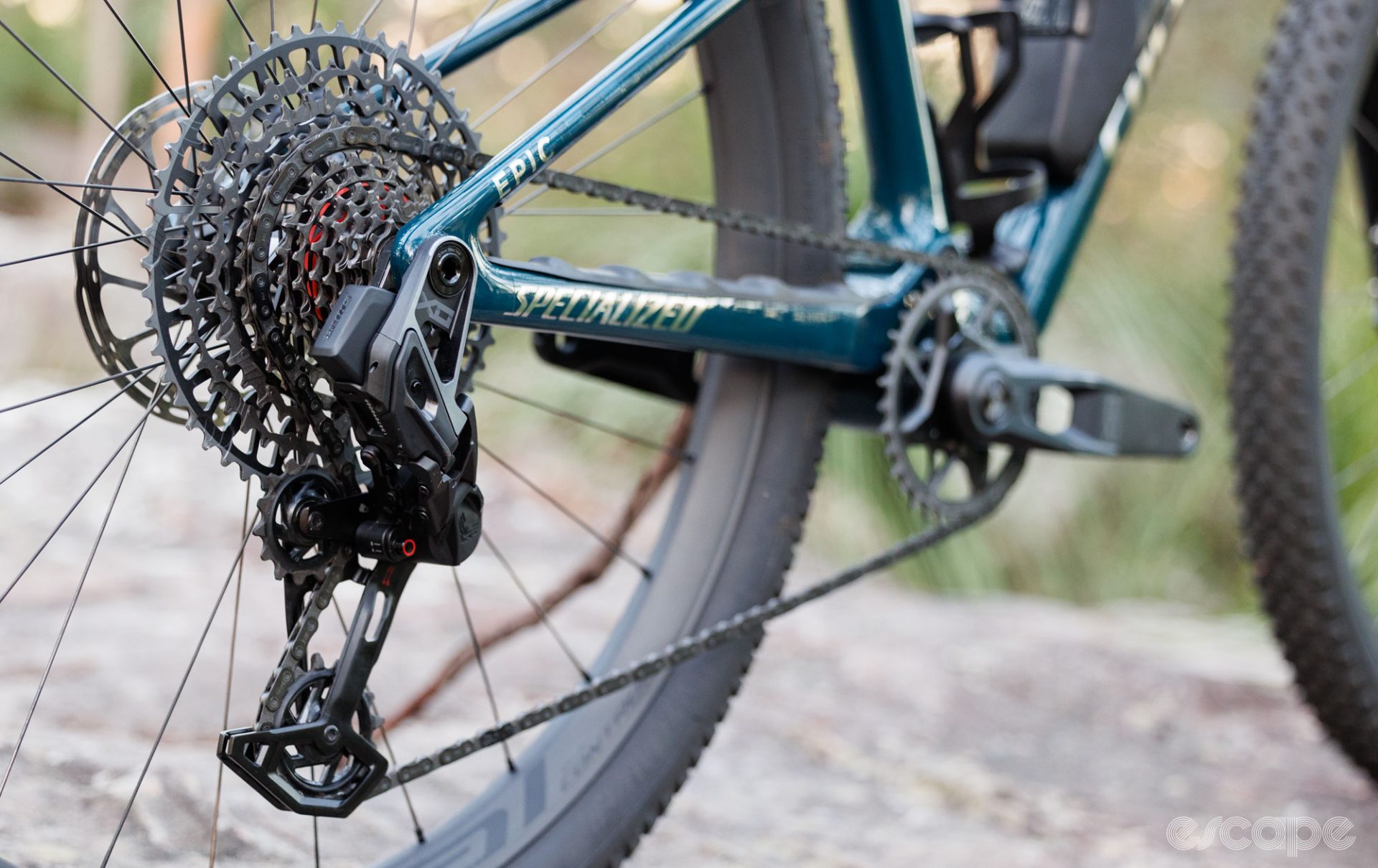
Speaking of Shimano GRX, it currently tops out at an approximate Ultegra-level of price and weight, whereas Red AXS is priced and weighted to compete with Dura-Ace. Currently, Shimano has no direct answer to the new Red XPLR AXS. Yes, Shimano did recently release GRX Di2, but it’s currently only available in a 2x configuration, while the 1x version is rumoured to be due in 2025. Meanwhile, Shimano’s GRX mechanical in 1x variants is really good, but it simply doesn't offer the set-and-forget ownership of electric shifting (especially when you consider how bad the cable routing is on many new bikes).

Meanwhile, Campagnolo Ekar is an interesting choice, but it’s last on my list. It being mechanical shifting and 13-speed makes it more sensitive to adjustment and all-too-fussy over cable routing, cable quality, and cable health. Throw some real mud, muck, or neglect into the mix and it gets, well, shitty. That’s enough to rule it out for me, but then the lever ergonomics are not for me, either.
A wrap and what the new Red XPLR spells for the future of road
New Red XPLR AXS isn’t likely to change your average speed or suddenly get you to the podium, but it is a great product. It brings simpler ownership with a carefree level of robustness into an area of the bike that’s often first to fail.
Add in those new excellent brakes, the comfy levers, a brilliant power meter, a long-lasting chain, and the easy installation/ownership of a wireless drivetrain, and that’s why I’m comfortable stating that SRAM is currently leading the pack in graveI.
There’s no arguing that this new Red XPLR stuff is priced for those with champagne tastes and an actual champagne budget. However, the Full Mount derailleur and better brakes are absolutely going to trickle down to more affordable price points and SRAM has a history of doing such things quickly. I also don’t see the Full Mount design as being exclusive to premium-priced electronic shifting, and I have hope for a budget-friendly 11- or 12-speed mechanical version in years to come. Additionally, I’d think it’s entirely possible for SRAM to make a 2x-compatible derailleur that works off this interface. However, the bad news is that your existing bike (unless it’s UDH) won’t be compatible with any of it.
Expect the transition of UDH adoption from the industry to move quickly. “Every brand has plans to add UDH to their gravel bikes,” shared JP McCarthy, hinting at what the future may hold. “There are also many major brands who plan to adopt UDH for all dropbar bikes [ed. you can obviously add Trek to that list].”
The adoption of UDH in dropbar bikes is rapidly on the rise. New Red XPLR now makes it clear why so many new gravel bikes are going that way, and the writing is on the wall for why we’re seeing road bikes adopting it, too.
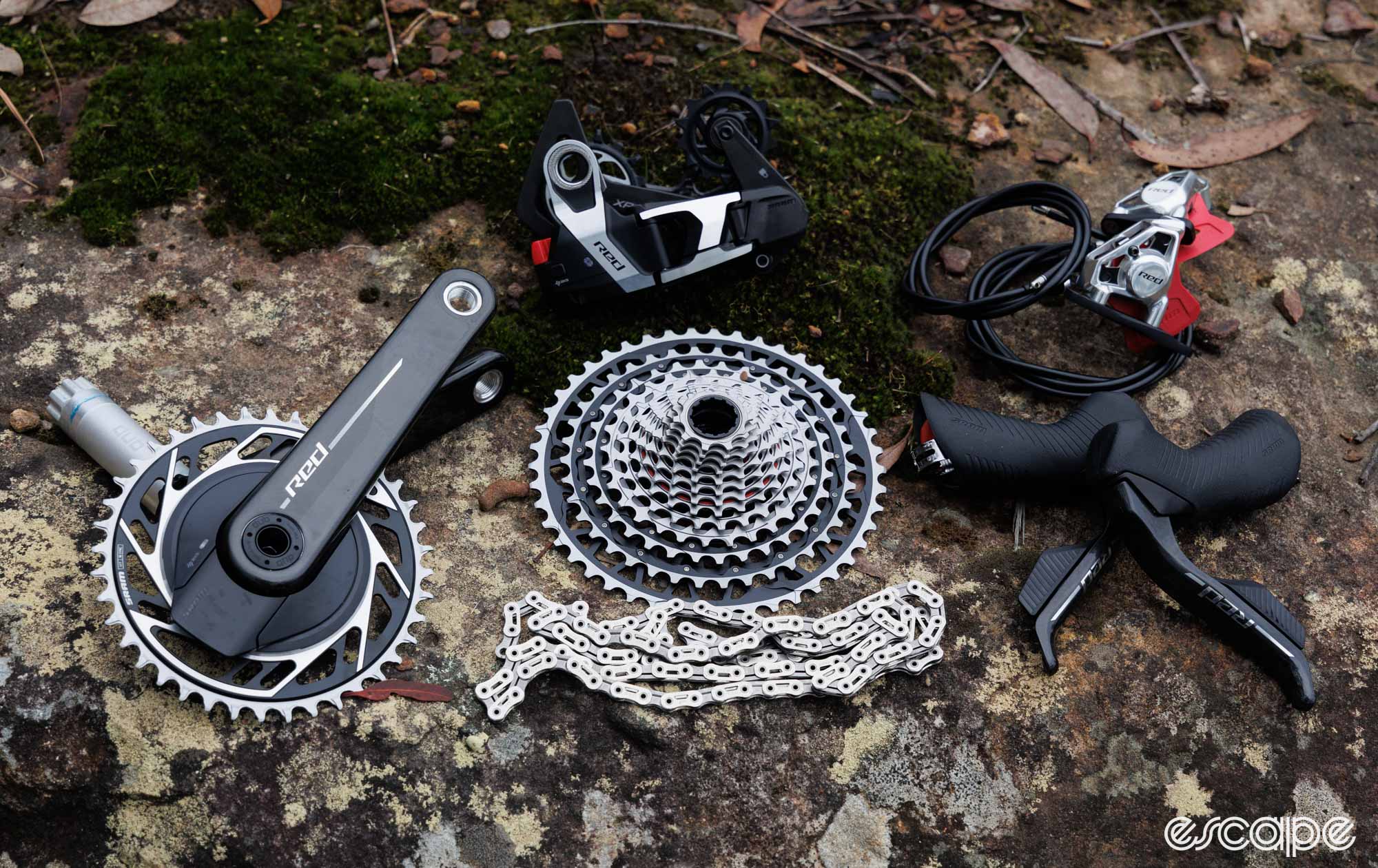
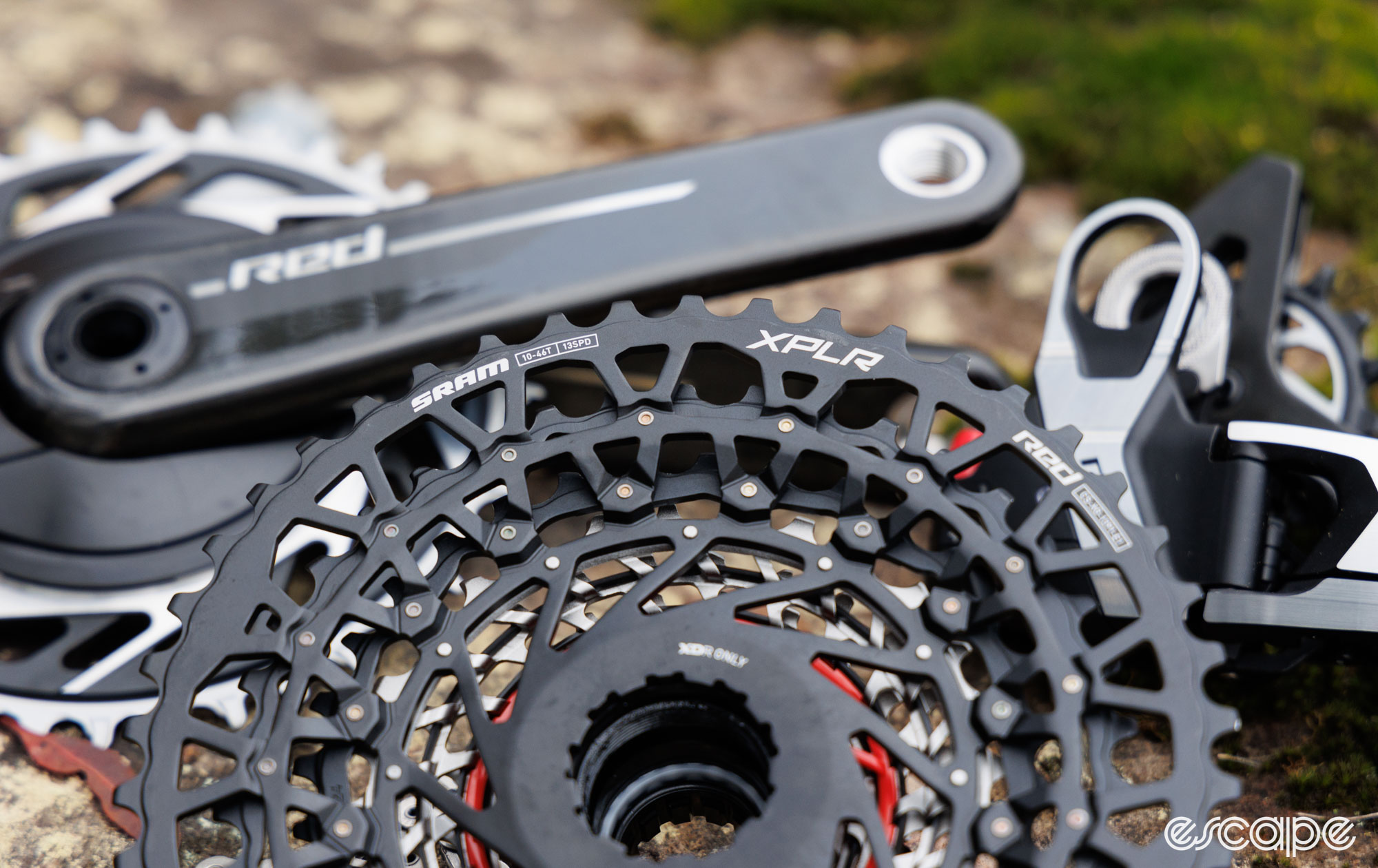



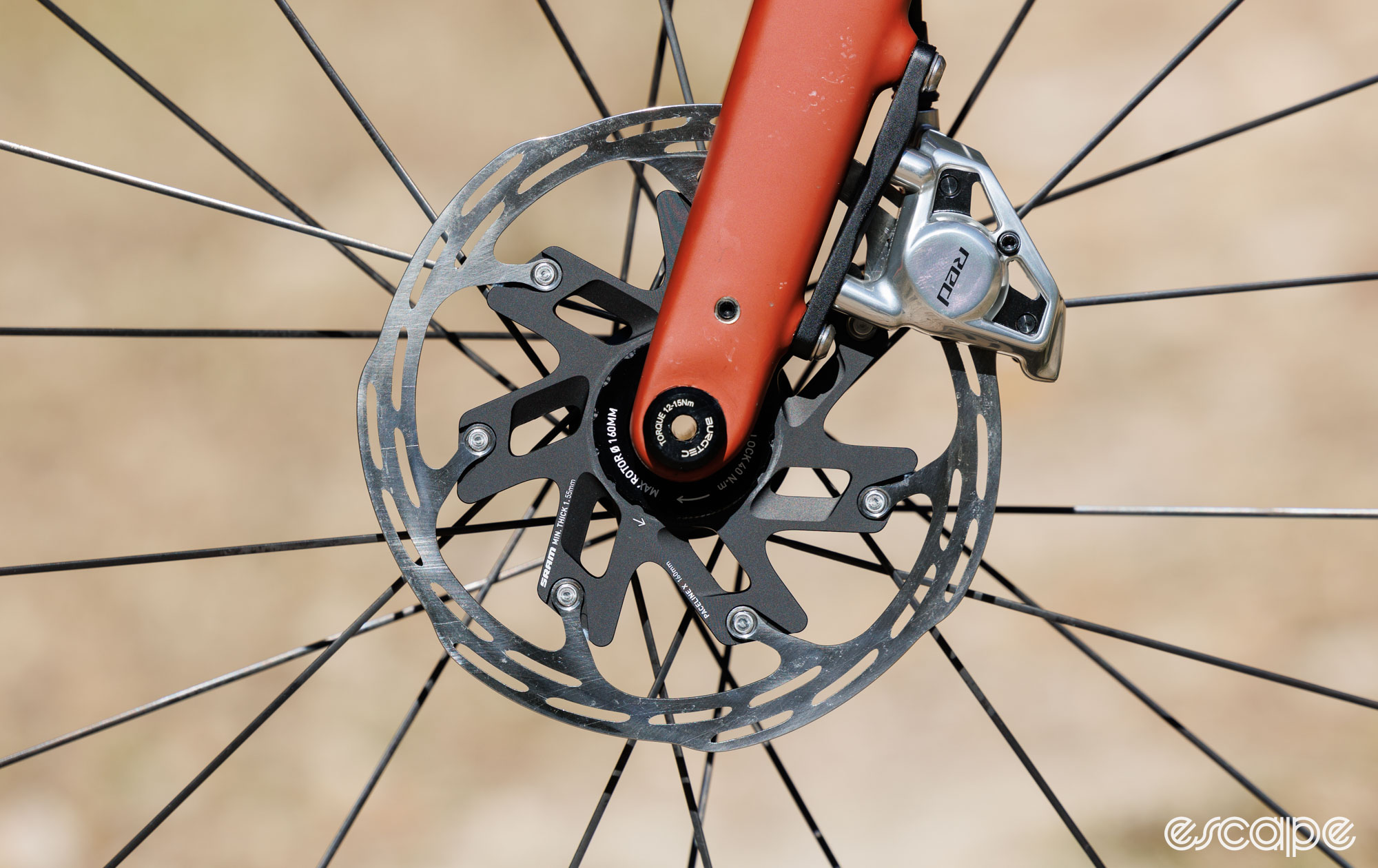
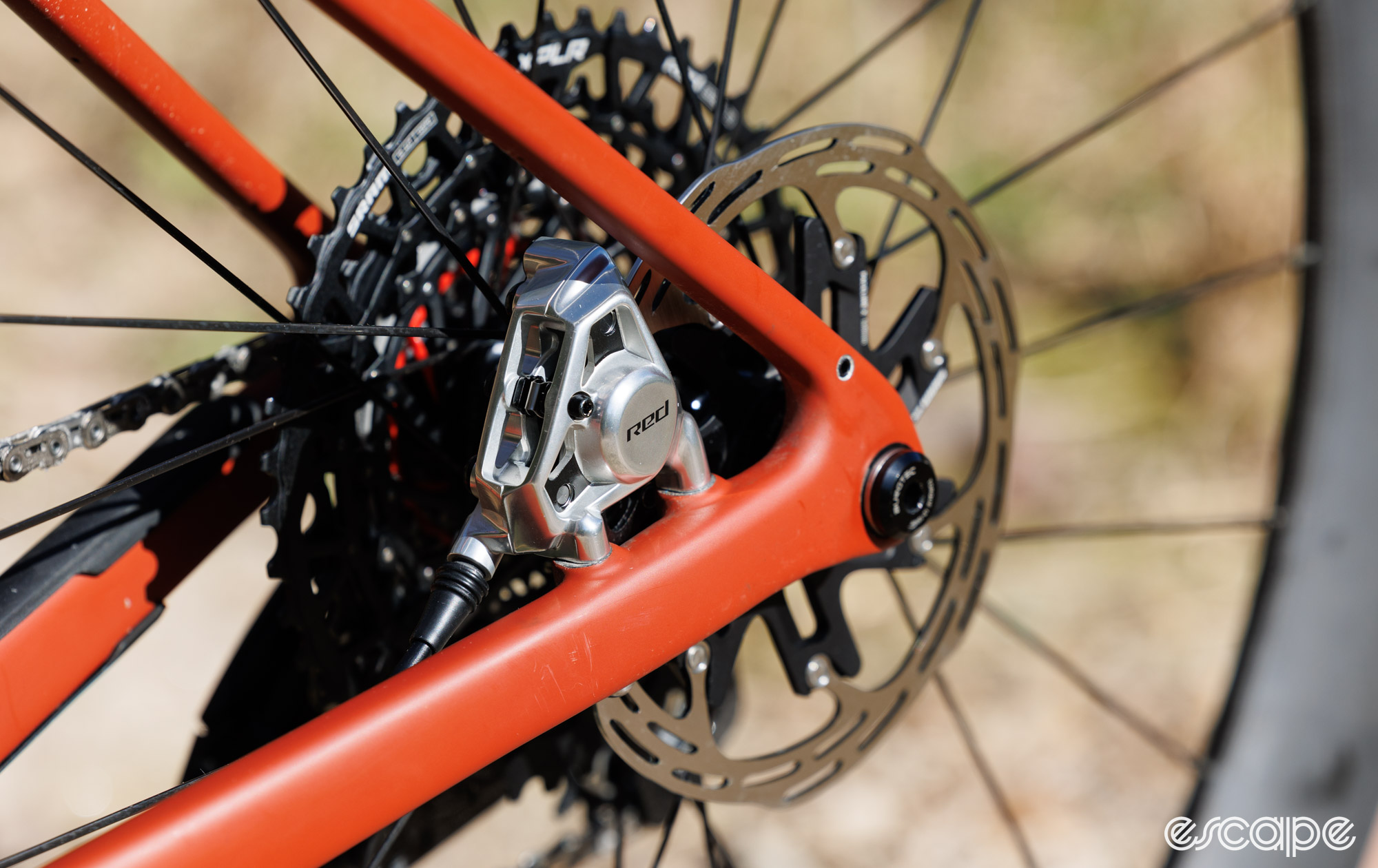

Did we do a good job with this story?

